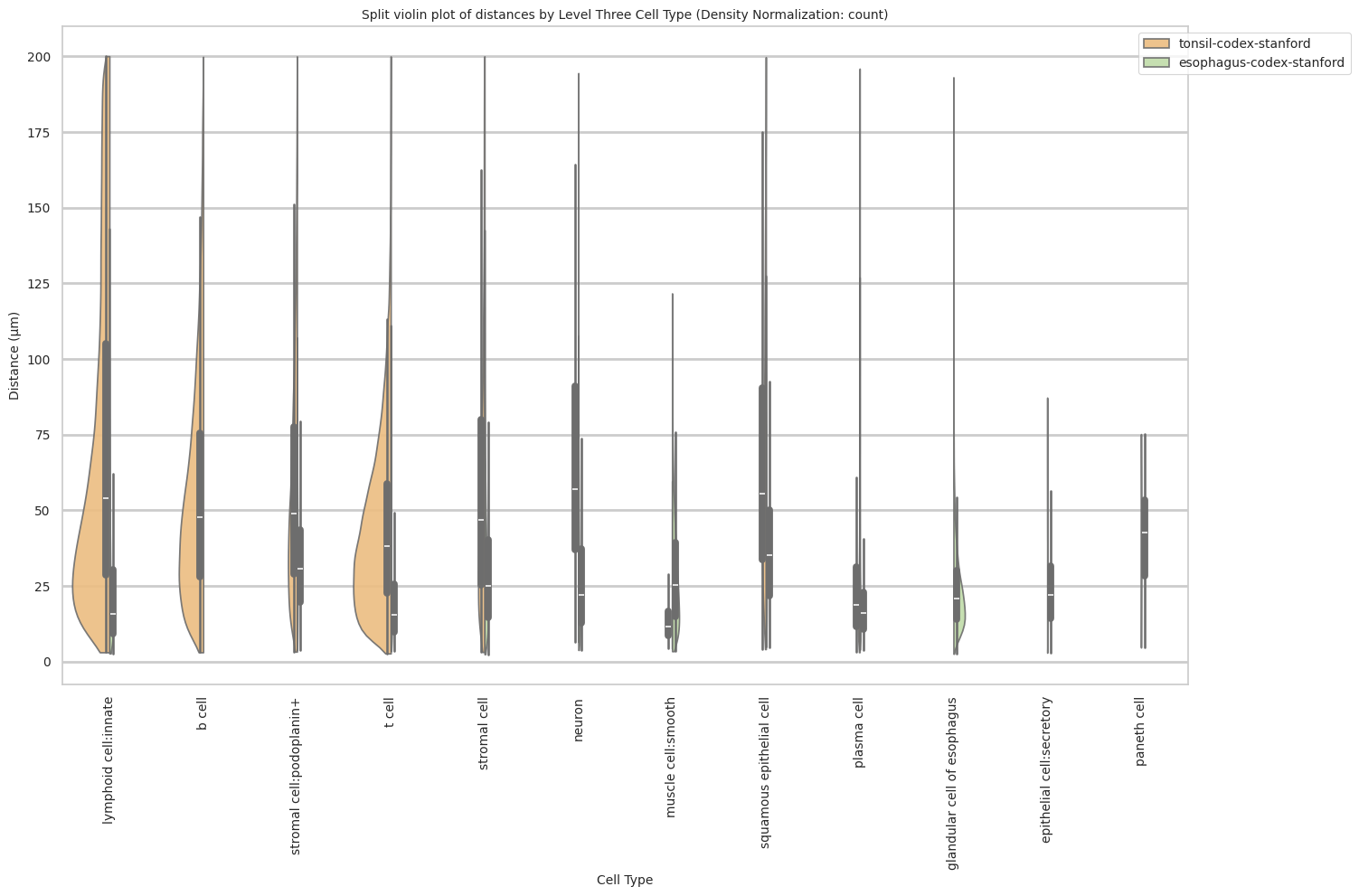import numpy as np
import pandas as pd
import os
import json
import requests
import shutil
import matplotlib.pyplot as plt
import seaborn as sns
from sklearn.preprocessing import normalize
import plotly.express as px
from _cde_compute_edges_from_nodes import *
pd.set_option('display.max_columns', None)
pd.set_option('display.max_rows', None)
# suppress warnings
import warnings
warnings.filterwarnings("ignore")Distance Analysis: tonsil-codex-stanford and esophagus-codex-stanford
Analyze and visualize cell-to-nearest-endothelial-cell distance distributions for the
tonsil-codex-stanford and esophagus-codex-stanford datasets.
basepath = "/u/yashjain/hra-cell-distance-analysis/data"
dataset_dir = "tonsil-esophagus-codex-stanford" # This variable is used only for figures.
dataset_dir_1 = "tonsil-codex-stanford" # This variable is used for data loading dataset 1.
dataset_dir_2 = "esophagus-codex-stanford" # This variable is used for data loading dataset 2.
data_filedir_1 = os.path.join("data-processed-nodes-with-harmonized-cell-types", dataset_dir_1)
output_edge_dir_1 = os.path.join("data-processed-edges", dataset_dir_1)
data_filedir_2 = os.path.join("data-processed-nodes-with-harmonized-cell-types", dataset_dir_2)
output_edge_dir_2 = os.path.join("data-processed-edges", dataset_dir_2)
figures_output_dir = "generated-figures"# Function to load your data
def load_data(path, edges=False):
if edges:
column_names = ['cell_id', 'x1', 'y1', 'z1', 'x2', 'y2', 'z2']
data = pd.read_csv(path, header=None, names=column_names)
else:
data = pd.read_csv(path)
return data# Function to read all files ending with "-nodes.csv" in the `data_filedir` directory into a single DataFrame.
# Another additional column `Dataset` is added to identify the dataset name which comes from the filename before the `-nodes.csv` suffix.
# Additionally, function reads all files ending with "-edges.csv" in the `output_edge_dir` directory into a single DataFrame.
# Three additional columns are added "Dataset", "Anchor Cell Type", and "Anchor Cell Type Level" to identify the dataset name, anchor cell type, and anchor cell type level respectively which come from the filename before the `.csv` suffix.
# The three additional columns are created by splitting the filename on the `-` character, and extracting the relevant parts.
# On splitting, the first part is the dataset name, second part is the anchor cell type level, and third part is the anchor cell type, and last part is the `edges` suffix.
# When reading files, check if the file has the correct format (i.e., ends with `-edges.csv`).
# Additionally, the function merges the edges DataFrame with the nodes DataFrame to get the cell type information for the anchor cells.
# This is done by reading the corresponding nodes file from the `data_filedir` directory for each edges file, and merging it with the edges DataFrame on the `cell_id` column.
# The merged DataFrame contains the edges with additional columns for the cell type information.
# The function returns three DataFrames:
# 1. `merged_nodes`: DataFrame containing all nodes with an additional column `Dataset`.
# 2. `merged_edges`: DataFrame containing all edges with additional columns `Dataset`, `Anchor Cell Type`, and `Anchor Cell Type Level`.
# 3. `merged_nodes_for_all_edges`: DataFrame containing all edges with additional columns `Dataset`, `Anchor Cell Type`, `Anchor Cell Type Level`, and the cell type information for cells.
def read_all_edge_datasets(basepath, data_filedir, output_edge_dir):
all_nodes_files = []
all_edges_files = []
all_nodes_edges_files = []
for file in os.listdir(os.path.join(basepath, output_edge_dir)):
if file.endswith("-edges.csv"):
file_path = os.path.join(basepath, output_edge_dir, file)
dataset_name, anchor_cell_type_level, anchor_cell_type = file.replace("-edges.csv", "").split('-')
edges_df = load_data(file_path, edges=False)
edges_df['Dataset'] = dataset_name
edges_df['Anchor Cell Type'] = anchor_cell_type
edges_df['Anchor Cell Type Level'] = anchor_cell_type_level
edges_df.rename(columns={"distance": "Distance"}, inplace=True) # Rename column "distance" to "Distance".
all_edges_files.append(edges_df)
# Read the corresponding nodes file from data_filedir to get the cell type information
nodes_file_path = os.path.join(basepath, data_filedir, f"{dataset_name}-nodes.csv")
nodes_df = load_data(nodes_file_path)
nodes_df['Dataset'] = dataset_name
all_nodes_files.append(nodes_df)
# Add a new 'cell_id' column to nodes_df
nodes_df['cell_id'] = range(len(nodes_df))
# Set 'cell_id' column as index for nodes_df
nodes_df.set_index('cell_id', inplace=True)
# Merge edges_df with nodes_df to get the cell type information for the anchor cells
edges_nodes_df = pd.merge(edges_df, nodes_df[['Level Three Cell Type', 'Level Two Cell Type', 'Level One Cell Type']], how='left', left_on='cell_id', right_index=True)
all_nodes_edges_files.append(edges_nodes_df)
merged_edges = pd.concat(all_edges_files, ignore_index=True)
merged_nodes = pd.concat(all_nodes_files, ignore_index=True)
merged_nodes_for_all_edges = pd.concat(all_nodes_edges_files, ignore_index=True)
return merged_nodes, merged_edges, merged_nodes_for_all_edgesdef create_directory(directory):
if not os.path.exists(directory):
os.makedirs(directory)
print(f"Directory '{directory}' created successfully.")
else:
print(f"Directory '{directory}' already exists.")Get initial statistics and identify endothelial cell categories for dataset.
# Read all datasets from Dataset 1
df_all_nodes_1, df_all_edges_1, df_all_edges_with_cell_types_1 = read_all_edge_datasets(basepath, data_filedir_1, output_edge_dir_1)
# Create a column 'Tissue Type' in all three DataFrames with the value dataset_dir_1
df_all_nodes_1['Tissue Type'] = dataset_dir_1
df_all_edges_1['Tissue Type'] = dataset_dir_1
df_all_edges_with_cell_types_1['Tissue Type'] = dataset_dir_1
# Read all datasets from Dataset 2
df_all_nodes_2, df_all_edges_2, df_all_edges_with_cell_types_2 = read_all_edge_datasets(basepath, data_filedir_2, output_edge_dir_2)
# Create a column 'Tissue Type' in all three DataFrames with the value dataset_dir_2
df_all_nodes_2['Tissue Type'] = dataset_dir_2
df_all_edges_2['Tissue Type'] = dataset_dir_2
df_all_edges_with_cell_types_2['Tissue Type'] = dataset_dir_2
# Merge the two datasets
df_all_nodes = pd.concat([df_all_nodes_1, df_all_nodes_2], ignore_index=True)
df_all_edges = pd.concat([df_all_edges_1, df_all_edges_2], ignore_index=True)
df_all_edges_with_cell_types = pd.concat([df_all_edges_with_cell_types_1, df_all_edges_with_cell_types_2], ignore_index=True)df_all_nodes.head(5)| x | y | Original Cell Type | Level Three Cell Type | Level Three CL Label | Level Three CL ID | CL_Match/3 | Level Two Cell Type | Level Two CL Label | Level Two CL ID | CL_Match/2 | Level One Cell Type | Level One CL Label | Level One CL ID | CL_Match/1 | Dataset | Tissue Type | |
|---|---|---|---|---|---|---|---|---|---|---|---|---|---|---|---|---|---|
| 0 | 148.538 | 1325.532 | Innate | lymphoid cell:innate | innate lymphoid cell | CL:0001065 | skos:exactMatch | lymphoid cell | lymphocyte | CL:0000542 | skos:exactMatch | immune cell | leukocyte | CL:0000738 | skos:exactMatch | tonsil | tonsil-codex-stanford |
| 1 | 2061.813 | 928.551 | Innate | lymphoid cell:innate | innate lymphoid cell | CL:0001065 | skos:exactMatch | lymphoid cell | lymphocyte | CL:0000542 | skos:exactMatch | immune cell | leukocyte | CL:0000738 | skos:exactMatch | tonsil | tonsil-codex-stanford |
| 2 | 944.762 | 1806.961 | PDPN | stromal cell:podoplanin+ | stromal cell:podoplanin-positive | CL:0000499 | skos:narrowMatch | stromal cell | stromal cell | CL:0000499 | skos:exactMatch | mesenchymal cell | mesenchymal cell | CL:0008019 | skos:exactMatch | tonsil | tonsil-codex-stanford |
| 3 | 3367.741 | 300.092 | Endothelial | endothelial cell | endothelial cell | CL:0000115 | skos:exactMatch | endothelial cell | endothelial cell | CL:0000115 | skos:exactMatch | endothelial cell | endothelial cell | CL:0000115 | skos:exactMatch | tonsil | tonsil-codex-stanford |
| 4 | 1806.961 | 710.645 | Innate | lymphoid cell:innate | innate lymphoid cell | CL:0001065 | skos:exactMatch | lymphoid cell | lymphocyte | CL:0000542 | skos:exactMatch | immune cell | leukocyte | CL:0000738 | skos:exactMatch | tonsil | tonsil-codex-stanford |
# Print the total number of unique cell types per dataset. Compute separately for each cell type column (Level One Cell Type, Level Two Cell Type, Level Three Cell Type, Original Cell Type).
print("Total number of unique cell types per cell type annnotation level:")
unique_cell_types = {
'Original Cell Type': df_all_nodes['Original Cell Type'].nunique(),
'Level Three Cell Type': df_all_nodes['Level Three Cell Type'].nunique(),
'Level Two Cell Type': df_all_nodes['Level Two Cell Type'].nunique(),
'Level One Cell Type': df_all_nodes['Level One Cell Type'].nunique()
}
for cell_type, count in unique_cell_types.items():
print(f"{cell_type}: {count}")Total number of unique cell types per cell type annnotation level:
Original Cell Type: 13
Level Three Cell Type: 13
Level Two Cell Type: 11
Level One Cell Type: 5# Save the unique cell types containing "endothelial" in name per cell type column (Level One Cell Type, Level Two Cell Type, Level Three Cell Type, Original Cell Type) to a dictionary where the key is the level and the value is a list of unique cell types.
endothelial_cell_types = {
'Original Cell Type': df_all_nodes[df_all_nodes['Original Cell Type'].str.contains("endothelial", case=False, na=False)]['Original Cell Type'].unique().tolist(),
'Level Three Cell Type': df_all_nodes[df_all_nodes['Level Three Cell Type'].str.contains("endothelial", case=False, na=False)]['Level Three Cell Type'].unique().tolist(),
'Level Two Cell Type': df_all_nodes[df_all_nodes['Level Two Cell Type'].str.contains("endothelial", case=False, na=False)]['Level Two Cell Type'].unique().tolist(),
'Level One Cell Type': df_all_nodes[df_all_nodes['Level One Cell Type'].str.contains("endothelial", case=False, na=False)]['Level One Cell Type'].unique().tolist()
}
print("\nEndothelial cell types per cell type annotation level:")
for level, cell_types in endothelial_cell_types.items():
print(f"\n{level}:")
for cell in cell_types:
print(f" - {cell}")
Endothelial cell types per cell type annotation level:
Original Cell Type:
- Endothelial
Level Three Cell Type:
- endothelial cell
Level Two Cell Type:
- endothelial cell
Level One Cell Type:
- endothelial celltype_field_list = ["Level Three Cell Type", "Level Two Cell Type", "Level One Cell Type"] # Skipping Original Cell Type as it is not a hierarchical level.
# Define the anchor cell type (type of endothelial cell) for each level in type_field_list based on available categories in the previous cell. The distance analysis at all three levels will be limited to the specified anchor cell type.
anchor_cell_type_dict = {
'Level Three Cell Type': 'endothelial cell',
'Level Two Cell Type': 'endothelial cell',
'Level One Cell Type': 'endothelial cell'
}Process datasets to add region information to Nodes files.
# Create a dictionary to map skin regions to correct condition.
region_map = {dataset_dir_1:'tonsil-codex-stanford',
dataset_dir_2:'esophagus-codex-stanford',
}
# Define the standard region sequence for plots
regions = ['tonsil-codex-stanford', 'esophagus-codex-stanford']df_all_nodes.head()| x | y | Original Cell Type | Level Three Cell Type | Level Three CL Label | Level Three CL ID | CL_Match/3 | Level Two Cell Type | Level Two CL Label | Level Two CL ID | CL_Match/2 | Level One Cell Type | Level One CL Label | Level One CL ID | CL_Match/1 | Dataset | Tissue Type | |
|---|---|---|---|---|---|---|---|---|---|---|---|---|---|---|---|---|---|
| 0 | 148.538 | 1325.532 | Innate | lymphoid cell:innate | innate lymphoid cell | CL:0001065 | skos:exactMatch | lymphoid cell | lymphocyte | CL:0000542 | skos:exactMatch | immune cell | leukocyte | CL:0000738 | skos:exactMatch | tonsil | tonsil-codex-stanford |
| 1 | 2061.813 | 928.551 | Innate | lymphoid cell:innate | innate lymphoid cell | CL:0001065 | skos:exactMatch | lymphoid cell | lymphocyte | CL:0000542 | skos:exactMatch | immune cell | leukocyte | CL:0000738 | skos:exactMatch | tonsil | tonsil-codex-stanford |
| 2 | 944.762 | 1806.961 | PDPN | stromal cell:podoplanin+ | stromal cell:podoplanin-positive | CL:0000499 | skos:narrowMatch | stromal cell | stromal cell | CL:0000499 | skos:exactMatch | mesenchymal cell | mesenchymal cell | CL:0008019 | skos:exactMatch | tonsil | tonsil-codex-stanford |
| 3 | 3367.741 | 300.092 | Endothelial | endothelial cell | endothelial cell | CL:0000115 | skos:exactMatch | endothelial cell | endothelial cell | CL:0000115 | skos:exactMatch | endothelial cell | endothelial cell | CL:0000115 | skos:exactMatch | tonsil | tonsil-codex-stanford |
| 4 | 1806.961 | 710.645 | Innate | lymphoid cell:innate | innate lymphoid cell | CL:0001065 | skos:exactMatch | lymphoid cell | lymphocyte | CL:0000542 | skos:exactMatch | immune cell | leukocyte | CL:0000738 | skos:exactMatch | tonsil | tonsil-codex-stanford |
# Iterate through the df_all_data dataframe to create new column "Unique Region" based on the "Tissue Type" column.
# The "Unique Region" column is created by mapping the region names based on the full dataset name.
df_all_nodes['Unique Region'] = df_all_nodes['Tissue Type'].map(region_map)
# Check if the new columns are created correctly.
df_all_nodes[['Tissue Type', 'Unique Region']].head(5)| Tissue Type | Unique Region | |
|---|---|---|
| 0 | tonsil-codex-stanford | tonsil-codex-stanford |
| 1 | tonsil-codex-stanford | tonsil-codex-stanford |
| 2 | tonsil-codex-stanford | tonsil-codex-stanford |
| 3 | tonsil-codex-stanford | tonsil-codex-stanford |
| 4 | tonsil-codex-stanford | tonsil-codex-stanford |
# Print all unique regions in the data.
print("\nUnique Regions in the data:")
print(df_all_nodes['Unique Region'].unique())
# Print the total number of unique regions.
print(f"Total number of unique regions: {df_all_nodes['Unique Region'].nunique()}")
# Print number of unique datasets per unique region.
print("\nNumber of unique datasets per unique region:")
for region in df_all_nodes['Unique Region'].unique():
num_datasets = df_all_nodes[df_all_nodes['Unique Region'] == region]['Dataset'].nunique()
print(f"{region}: {num_datasets}")
Unique Regions in the data:
['tonsil-codex-stanford' 'esophagus-codex-stanford']
Total number of unique regions: 2
Number of unique datasets per unique region:
tonsil-codex-stanford: 1
esophagus-codex-stanford: 1Process datasets to add region information to Edges files.
df_all_edges.head(5)| cell_id | x1 | y1 | z1 | x2 | y2 | z2 | Distance | Dataset | Anchor Cell Type | Anchor Cell Type Level | Tissue Type | |
|---|---|---|---|---|---|---|---|---|---|---|---|---|
| 0 | 0 | 148.538 | 1325.532 | 0 | 96.889 | 1333.449 | 0 | 52.252254 | tonsil | endothelial cell | Level Three Cell Type | tonsil-codex-stanford |
| 1 | 190 | 183.599 | 1254.656 | 0 | 96.889 | 1333.449 | 0 | 117.162114 | tonsil | endothelial cell | Level Three Cell Type | tonsil-codex-stanford |
| 2 | 242 | 180.583 | 1235.052 | 0 | 109.330 | 1150.227 | 0 | 110.780281 | tonsil | endothelial cell | Level Three Cell Type | tonsil-codex-stanford |
| 3 | 609 | 163.618 | 1238.445 | 0 | 109.330 | 1150.227 | 0 | 103.583794 | tonsil | endothelial cell | Level Three Cell Type | tonsil-codex-stanford |
| 4 | 836 | 88.595 | 1252.394 | 0 | 56.550 | 1316.484 | 0 | 71.654798 | tonsil | endothelial cell | Level Three Cell Type | tonsil-codex-stanford |
# Process the edge data to create new columns "Unique Region" based on the "Tissue Type" column, similar to how it was done for the node data.
df_all_edges['Unique Region'] = df_all_edges['Tissue Type'].map(region_map)
# Check if the new columns are created correctly.
df_all_edges[['Tissue Type', 'Unique Region']].head(5)| Tissue Type | Unique Region | |
|---|---|---|
| 0 | tonsil-codex-stanford | tonsil-codex-stanford |
| 1 | tonsil-codex-stanford | tonsil-codex-stanford |
| 2 | tonsil-codex-stanford | tonsil-codex-stanford |
| 3 | tonsil-codex-stanford | tonsil-codex-stanford |
| 4 | tonsil-codex-stanford | tonsil-codex-stanford |
# Print all unique regions in the data.
print("\nUnique Regions in the data:")
print(df_all_edges['Unique Region'].unique())
# Print the total number of unique regions.
print(f"Total number of unique regions: {df_all_edges['Unique Region'].nunique()}")
# Print number of unique datasets per unique region.
print("\nNumber of unique datasets per unique region:")
for region in df_all_edges['Unique Region'].unique():
num_datasets = df_all_edges[df_all_edges['Unique Region'] == region]['Dataset'].nunique()
print(f"{region}: {num_datasets}")
Unique Regions in the data:
['tonsil-codex-stanford' 'esophagus-codex-stanford']
Total number of unique regions: 2
Number of unique datasets per unique region:
tonsil-codex-stanford: 1
esophagus-codex-stanford: 1df_all_edges_with_cell_types['Unique Region'] = df_all_edges_with_cell_types['Tissue Type'].map(region_map)
# Check if the new columns are created correctly.
df_all_edges_with_cell_types[['Tissue Type', 'Unique Region']].head(5)| Tissue Type | Unique Region | |
|---|---|---|
| 0 | tonsil-codex-stanford | tonsil-codex-stanford |
| 1 | tonsil-codex-stanford | tonsil-codex-stanford |
| 2 | tonsil-codex-stanford | tonsil-codex-stanford |
| 3 | tonsil-codex-stanford | tonsil-codex-stanford |
| 4 | tonsil-codex-stanford | tonsil-codex-stanford |
df_all_nodes.head(1)| x | y | Original Cell Type | Level Three Cell Type | Level Three CL Label | Level Three CL ID | CL_Match/3 | Level Two Cell Type | Level Two CL Label | Level Two CL ID | CL_Match/2 | Level One Cell Type | Level One CL Label | Level One CL ID | CL_Match/1 | Dataset | Tissue Type | Unique Region | |
|---|---|---|---|---|---|---|---|---|---|---|---|---|---|---|---|---|---|---|
| 0 | 148.538 | 1325.532 | Innate | lymphoid cell:innate | innate lymphoid cell | CL:0001065 | skos:exactMatch | lymphoid cell | lymphocyte | CL:0000542 | skos:exactMatch | immune cell | leukocyte | CL:0000738 | skos:exactMatch | tonsil | tonsil-codex-stanford | tonsil-codex-stanford |
df_all_edges.head(1)| cell_id | x1 | y1 | z1 | x2 | y2 | z2 | Distance | Dataset | Anchor Cell Type | Anchor Cell Type Level | Tissue Type | Unique Region | |
|---|---|---|---|---|---|---|---|---|---|---|---|---|---|
| 0 | 0 | 148.538 | 1325.532 | 0 | 96.889 | 1333.449 | 0 | 52.252254 | tonsil | endothelial cell | Level Three Cell Type | tonsil-codex-stanford | tonsil-codex-stanford |
df_all_edges_with_cell_types.head(1)| cell_id | x1 | y1 | z1 | x2 | y2 | z2 | Distance | Dataset | Anchor Cell Type | Anchor Cell Type Level | Level Three Cell Type | Level Two Cell Type | Level One Cell Type | Tissue Type | Unique Region | |
|---|---|---|---|---|---|---|---|---|---|---|---|---|---|---|---|---|
| 0 | 0 | 148.538 | 1325.532 | 0 | 96.889 | 1333.449 | 0 | 52.252254 | tonsil | endothelial cell | Level Three Cell Type | lymphoid cell:innate | lymphoid cell | immune cell | tonsil-codex-stanford | tonsil-codex-stanford |
Node Analysis
# Plot number of cells per cell type in the same plot. Color by cell type and unique region. Output figure saved in existing `figures_output_dir`.
def plot_cells_per_celltype(df, type_field, output_dir):
plt.figure(figsize=(20, 8))
plt.rcParams["svg.fonttype"] = 'none' # to store text as text, not as path
sns.countplot(data=df, x=type_field, palette='Spectral', hue='Unique Region')
plt.title(f'Number of Cells per {type_field} in `{dataset_dir}`')
plt.xticks(rotation=90)
plt.tight_layout()
plt.savefig(os.path.join(output_dir, f'{dataset_dir}_cells_per_celltype_{type_field}.png'), dpi=300,
bbox_inches='tight',
pad_inches=0.5)
plt.savefig(os.path.join(output_dir, f'{dataset_dir}_cells_per_celltype_{type_field}.svg'), dpi=300,
bbox_inches='tight',
pad_inches=0.5)
plt.legend(title='Unique Region', bbox_to_anchor=(0.85, 1), loc='upper left')
plt.xlabel(type_field)
# For numbers on y-axis, do not use scientific notation.
plt.ticklabel_format(style='plain', axis='y')
# Set y-axis label
plt.ylabel('Number of Cells')
plt.grid(axis='y', linestyle='--', alpha=0.7)
plt.tight_layout()
# Show the plot
plt.show()
plt.close()
for type_field in type_field_list:
plot_cells_per_celltype(df_all_nodes, type_field, os.path.join(basepath, figures_output_dir))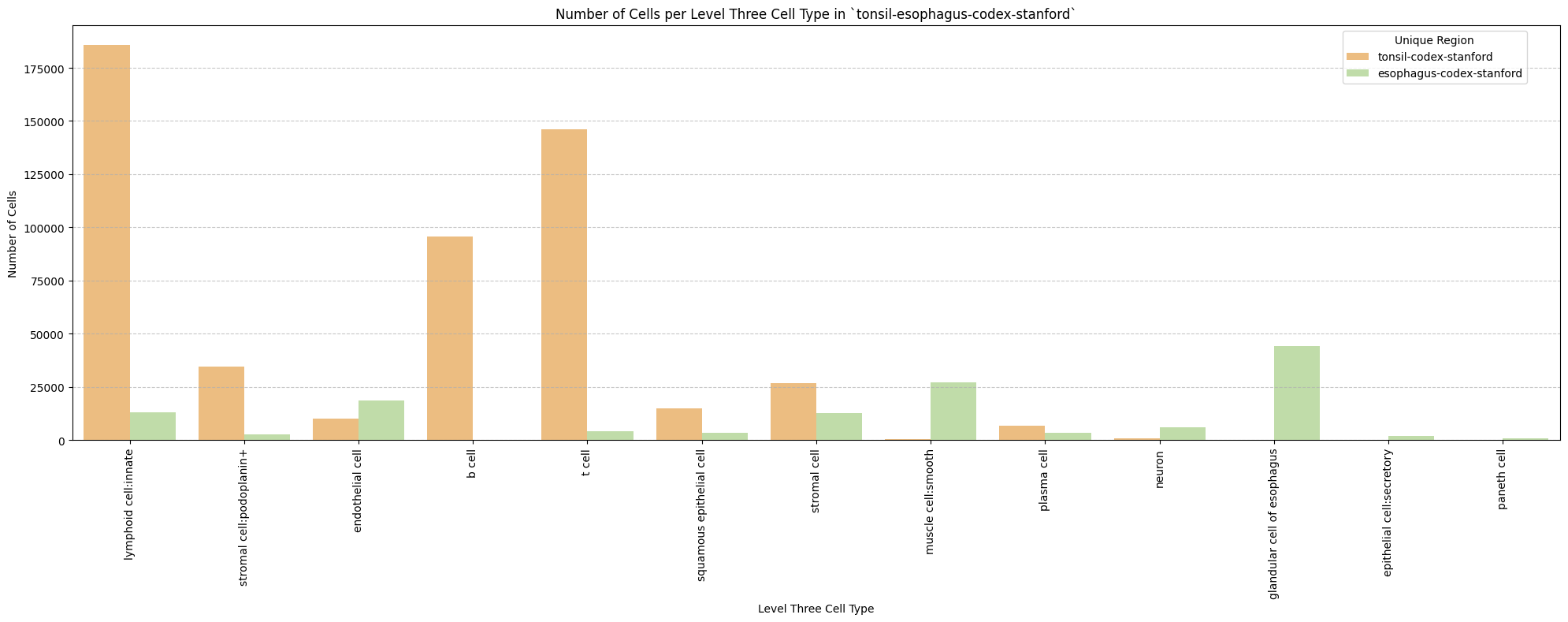
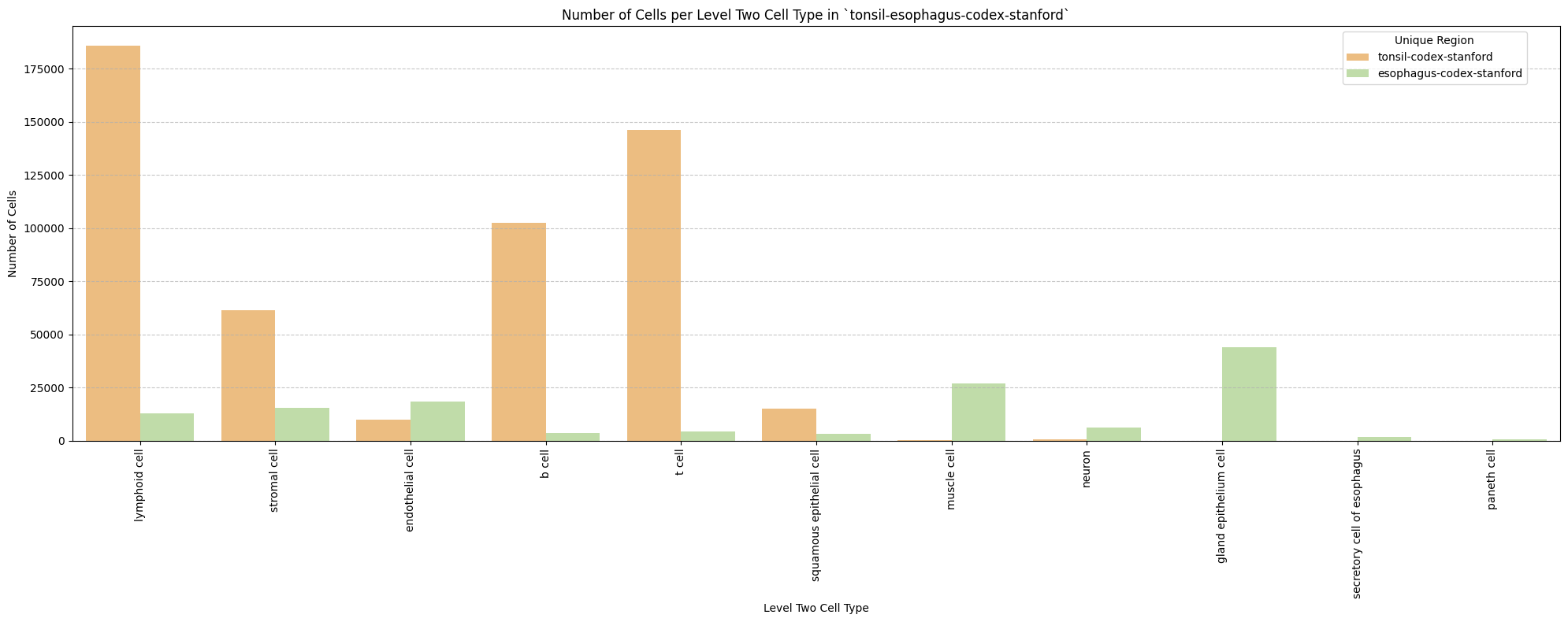
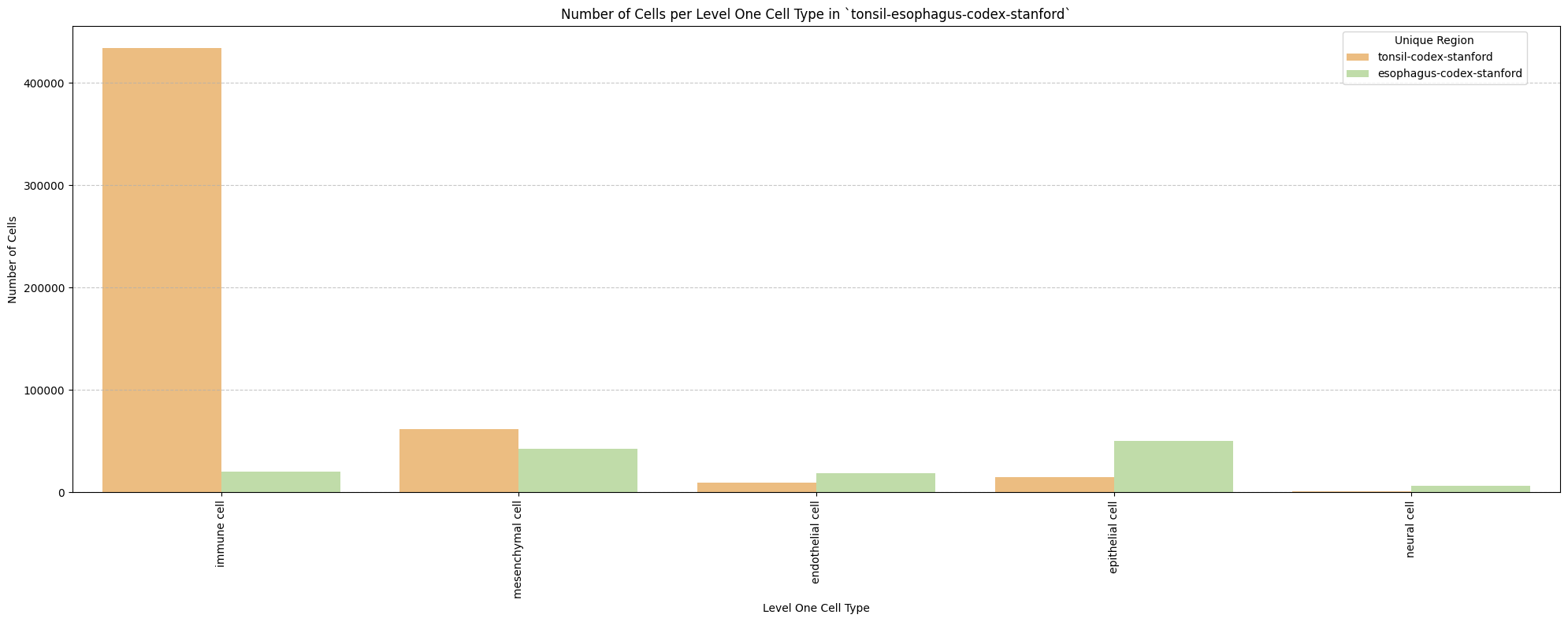
Distance Analysis
# Get mean, median, minimum, maximum distance per unique region per anchor cell type.
df_distance_stats = df_all_edges_with_cell_types.groupby(['Unique Region', 'Anchor Cell Type', 'Anchor Cell Type Level']).agg(
mean_distance=('Distance', 'mean'),
median_distance=('Distance', 'median'),
min_distance=('Distance', 'min'),
max_distance=('Distance', 'max')
).reset_index()
# Print the first few rows of the distance statistics DataFrame.
df_distance_stats| Unique Region | Anchor Cell Type | Anchor Cell Type Level | mean_distance | median_distance | min_distance | max_distance | |
|---|---|---|---|---|---|---|---|
| 0 | esophagus-codex-stanford | endothelial cell | Level One Cell Type | 26.201365 | 21.751953 | 2.384357 | 193.046457 |
| 1 | esophagus-codex-stanford | endothelial cell | Level Three Cell Type | 26.201365 | 21.751953 | 2.384357 | 193.046457 |
| 2 | esophagus-codex-stanford | endothelial cell | Level Two Cell Type | 26.201365 | 21.751953 | 2.384357 | 193.046457 |
| 3 | tonsil-codex-stanford | endothelial cell | Level One Cell Type | 56.899226 | 45.210144 | 2.639000 | 199.993437 |
| 4 | tonsil-codex-stanford | endothelial cell | Level Three Cell Type | 56.899226 | 45.210144 | 2.639000 | 199.993437 |
| 5 | tonsil-codex-stanford | endothelial cell | Level Two Cell Type | 56.899226 | 45.210144 | 2.639000 | 199.993437 |
Level One Cell Type Analysis
# Get mean, median, minimum, maximum distance per cell type in all unique regions.
cell_type_level = 'Level One Cell Type'
df_all_edges_with_cell_type_level = df_all_edges_with_cell_types[(df_all_edges_with_cell_types['Anchor Cell Type Level'] == cell_type_level) & (df_all_edges_with_cell_types['Anchor Cell Type'] == anchor_cell_type_dict[cell_type_level])]
df_distance_stats_cell_type_level = df_all_edges_with_cell_type_level.groupby([cell_type_level, 'Unique Region']).agg(
mean_distance=('Distance', 'mean'),
median_distance=('Distance', 'median'),
min_distance=('Distance', 'min'),
max_distance=('Distance', 'max')
).reset_index()
df_distance_stats_cell_type_level| Level One Cell Type | Unique Region | mean_distance | median_distance | min_distance | max_distance | |
|---|---|---|---|---|---|---|
| 0 | epithelial cell | esophagus-codex-stanford | 25.325414 | 21.492307 | 2.528993 | 193.046457 |
| 1 | epithelial cell | tonsil-codex-stanford | 65.469626 | 55.553479 | 4.060414 | 199.673736 |
| 2 | immune cell | esophagus-codex-stanford | 21.482974 | 15.712354 | 2.639000 | 143.075846 |
| 3 | immune cell | tonsil-codex-stanford | 56.521626 | 44.457236 | 2.639000 | 199.993437 |
| 4 | mesenchymal cell | esophagus-codex-stanford | 29.463088 | 25.393686 | 2.384357 | 142.577791 |
| 5 | mesenchymal cell | tonsil-codex-stanford | 57.159447 | 47.676714 | 3.108822 | 199.931243 |
| 6 | neural cell | esophagus-codex-stanford | 26.639884 | 22.024674 | 3.788803 | 107.653801 |
| 7 | neural cell | tonsil-codex-stanford | 66.127466 | 57.077850 | 6.409000 | 194.409948 |
# Get top five and bottom five cell types with respect to mean distance in each unique region separately.
def get_top_bottom_cell_types_by_mean(df, cell_type_level, unique_region, top_n=5):
# Filter the DataFrame for the specified unique region and cell type level
df_filtered = df[df['Unique Region'] == unique_region]
# Group by the specified cell type level and calculate mean distance
df_grouped = df_filtered.groupby(cell_type_level).agg(mean_distance=('Distance', 'mean')).reset_index()
# Sort by mean distance to get top and bottom cell types
df_sorted = df_grouped.sort_values(by='mean_distance', ascending=False)
# Get top N and bottom N cell types
top_cell_types = df_sorted.head(top_n)
bottom_cell_types = df_sorted.tail(top_n)
return top_cell_types, bottom_cell_types
# Get top and bottom cell types for each unique region in the dataset.
unique_regions = df_all_edges_with_cell_type_level['Unique Region'].unique()
for region in unique_regions:
top_bottom = get_top_bottom_cell_types_by_mean(df_all_edges_with_cell_type_level, cell_type_level, region)
print(f"\nTop 5 cell types in {region}:")
print(top_bottom[0])
print(f"\nBottom 5 cell types in {region}:")
print(top_bottom[1])
Top 5 cell types in tonsil-codex-stanford:
Level One Cell Type mean_distance
3 neural cell 66.127466
0 epithelial cell 65.469626
2 mesenchymal cell 57.159447
1 immune cell 56.521626
Bottom 5 cell types in tonsil-codex-stanford:
Level One Cell Type mean_distance
3 neural cell 66.127466
0 epithelial cell 65.469626
2 mesenchymal cell 57.159447
1 immune cell 56.521626
Top 5 cell types in esophagus-codex-stanford:
Level One Cell Type mean_distance
2 mesenchymal cell 29.463088
3 neural cell 26.639884
0 epithelial cell 25.325414
1 immune cell 21.482974
Bottom 5 cell types in esophagus-codex-stanford:
Level One Cell Type mean_distance
2 mesenchymal cell 29.463088
3 neural cell 26.639884
0 epithelial cell 25.325414
1 immune cell 21.482974# Get top five and bottom five cell types with respect to median distance in each unique region separately.
def get_top_bottom_cell_types_by_median(df, cell_type_level, unique_region, top_n=5):
# Filter the DataFrame for the specified unique region and cell type level
df_filtered = df[df['Unique Region'] == unique_region]
# Group by the specified cell type level and calculate median distance
df_grouped = df_filtered.groupby(cell_type_level).agg(median_distance=('Distance', 'median')).reset_index()
# Sort by median distance to get top and bottom cell types
df_sorted = df_grouped.sort_values(by='median_distance', ascending=False)
# Get top N and bottom N cell types
top_cell_types = df_sorted.head(top_n)
bottom_cell_types = df_sorted.tail(top_n)
return top_cell_types, bottom_cell_types
# Get top and bottom cell types for each unique region in the dataset.
unique_regions = df_all_edges_with_cell_type_level['Unique Region'].unique()
for region in unique_regions:
top_bottom = get_top_bottom_cell_types_by_median(df_all_edges_with_cell_type_level, cell_type_level, region)
print(f"\nTop 5 cell types in {region}:")
print(top_bottom[0])
print(f"\nBottom 5 cell types in {region}:")
print(top_bottom[1])
Top 5 cell types in tonsil-codex-stanford:
Level One Cell Type median_distance
3 neural cell 57.077850
0 epithelial cell 55.553479
2 mesenchymal cell 47.676714
1 immune cell 44.457236
Bottom 5 cell types in tonsil-codex-stanford:
Level One Cell Type median_distance
3 neural cell 57.077850
0 epithelial cell 55.553479
2 mesenchymal cell 47.676714
1 immune cell 44.457236
Top 5 cell types in esophagus-codex-stanford:
Level One Cell Type median_distance
2 mesenchymal cell 25.393686
3 neural cell 22.024674
0 epithelial cell 21.492307
1 immune cell 15.712354
Bottom 5 cell types in esophagus-codex-stanford:
Level One Cell Type median_distance
2 mesenchymal cell 25.393686
3 neural cell 22.024674
0 epithelial cell 21.492307
1 immune cell 15.712354# Calculate regional variability
def calculate_regional_variability(df_all_edges_with_cell_type_level, cell_type_level):
""" Calculate regional variability for distances in the given DataFrame.
"""
regional_variability = df_all_edges_with_cell_type_level.groupby('Unique Region')['Distance'].agg([
('mean', 'mean'),
('std', 'std')
]).round(2)
# Add CV as percentage
regional_variability['CV (%)'] = (regional_variability['std'] / regional_variability['mean'] * 100).round(1)
print("\nRegional Variability Analysis:")
print("Mean: Average distance in each region")
print("Std: Standard deviation of distances")
print("CV: Coefficient of Variation (std/mean * 100%)")
print(regional_variability)
# Calculate variability for each cell type
cell_type_variability = df_all_edges_with_cell_type_level.groupby(cell_type_level)['Distance'].agg([
('mean', 'mean'),
('std', 'std')
]).round(2)
# Add CV as percentage
cell_type_variability['CV (%)'] = (cell_type_variability['std'] / cell_type_variability['mean'] * 100).round(1)
print("\nCell Type Variability Analysis (sorted by CV):")
print(cell_type_variability.sort_values('CV (%)', ascending=False))
calculate_regional_variability(df_all_edges_with_cell_type_level, cell_type_level)
Regional Variability Analysis:
Mean: Average distance in each region
Std: Standard deviation of distances
CV: Coefficient of Variation (std/mean * 100%)
mean std CV (%)
Unique Region
esophagus-codex-stanford 26.2 17.46 66.6
tonsil-codex-stanford 56.9 42.08 74.0
Cell Type Variability Analysis (sorted by CV):
mean std CV (%)
Level One Cell Type
epithelial cell 34.36 29.16 84.9
neural cell 31.35 24.62 78.5
mesenchymal cell 45.67 35.37 77.4
immune cell 54.77 42.25 77.1# Generate Violin Plot
def plot_violin_cells_per_celltype(df_all_edges_with_cell_type_level, cell_type_level, output_dir, density_norm='area'):
sns.set_style("whitegrid")
sns.set_context("notebook", rc={"grid.linewidth": 2})
plt.figure(figsize=(10, 6))
plt.rcParams["svg.fonttype"] = 'none' # to store text as text, not as path
sns.violinplot(data=df_all_edges_with_cell_type_level, x=cell_type_level, y="Distance", density_norm=density_norm, common_norm=True, cut=0, inner="box", split=False, palette='Spectral', alpha=.9)
sns.set_theme(style="whitegrid")
sns.set_context("paper")
font_size = 10
plt.legend(fontsize=font_size)
plt.title(f'Violin Plot of distances by {cell_type_level} (Density Normalization: {density_norm})', fontsize=font_size)
plt.xlabel(f'{cell_type_level}', fontsize=font_size)
plt.ylabel('Distance (\u03bcm)', fontsize=font_size)
# Increase font size for all text in the figure
plt.xticks(fontsize=font_size)
plt.xticks(rotation=90)
plt.yticks(fontsize=font_size)
plt.tight_layout()
plt.savefig(os.path.join(output_dir, f'{dataset_dir}_violin_cells_per_celltype_{cell_type_level}.png'), dpi=300,
bbox_inches='tight',
pad_inches=0.5)
plt.savefig(os.path.join(output_dir, f'{dataset_dir}_violin_cells_per_celltype_{cell_type_level}.svg'), dpi=300,
bbox_inches='tight',
pad_inches=0.5)
plt.show()
plot_violin_cells_per_celltype(df_all_edges_with_cell_type_level, cell_type_level, os.path.join(basepath, figures_output_dir), density_norm='area')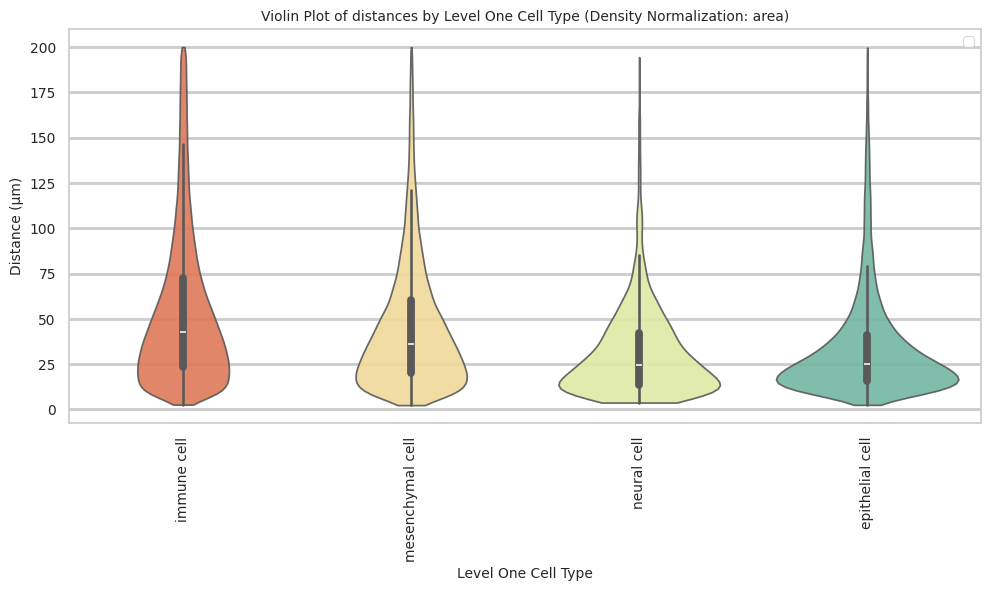
# Boxplots of distribution of distances by cell type and region.
def plot_distance_distribution_boxplots_by_region(df_all_edges_with_cell_type_level, cell_type_level, output_dir):
plt.figure(figsize=(16, 8))
plt.rcParams["svg.fonttype"] = 'none' # to store text as text, not as path
# Create categorical type with only the regions that exist in the data
available_regions = [r for r in regions if r in df_all_edges_with_cell_type_level['Unique Region'].unique()]
df_all_edges_with_cell_type_level['Unique Region'] = pd.Categorical(
df_all_edges_with_cell_type_level['Unique Region'],
categories=available_regions,
ordered=True
)
# Make box plot.
sns.boxplot(data=df_all_edges_with_cell_type_level, x=cell_type_level, y='Distance', hue='Unique Region', showfliers=False, palette='Spectral') # viridis or Spectral palette for better color distinction
font_size = 10
plt.xticks(rotation=90, ha='right', fontsize=font_size)
plt.yticks(fontsize=font_size)
plt.title(f'Distribution of distances by {cell_type_level} and region', fontsize=font_size)
plt.xlabel(f'{cell_type_level}', fontsize=font_size)
plt.ylabel('Distance (\u03bcm)', fontsize=font_size)
plt.legend(bbox_to_anchor=(1, 1), loc='upper left')
plt.tight_layout()
plt.savefig(os.path.join(output_dir, f'{dataset_dir}_distance_distribution_boxplots_by_region_{cell_type_level}.png'), dpi=300,
bbox_inches='tight',
pad_inches=0.5)
plt.savefig(os.path.join(output_dir, f'{dataset_dir}_distance_distribution_boxplots_by_region_{cell_type_level}.svg'), dpi=300,
bbox_inches='tight',
pad_inches=0.5)
plt.show()
plot_distance_distribution_boxplots_by_region(df_all_edges_with_cell_type_level, cell_type_level, os.path.join(basepath, figures_output_dir))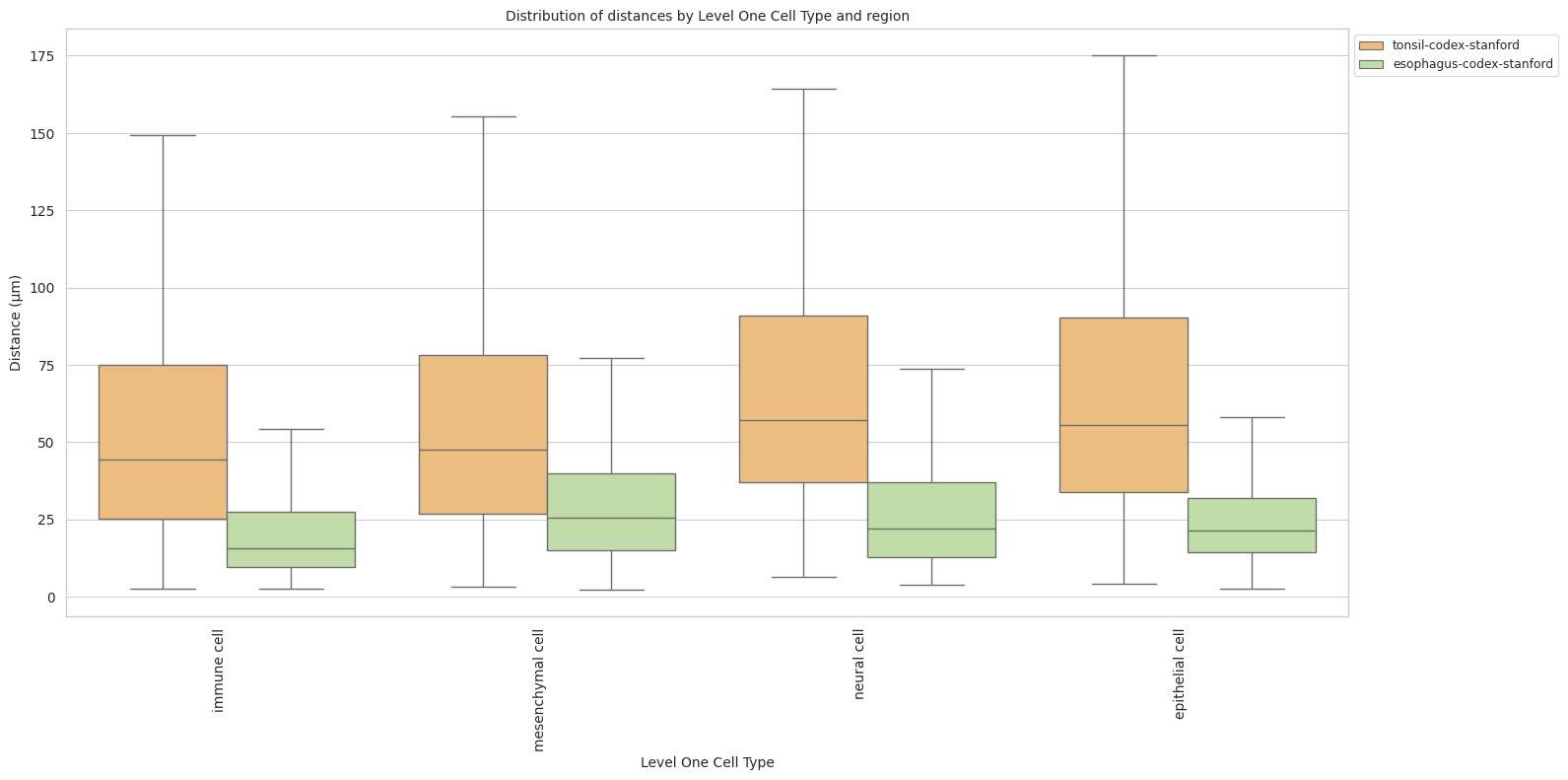
# Boxplots of distribution of distances by cell type and region.
def plot_distance_distribution_heatmap(df_all_edges_with_cell_type_level, cell_type_level, output_dir):
pivot_data = df_all_edges_with_cell_type_level.pivot_table(
values='Distance',
index=cell_type_level,
columns='Unique Region',
aggfunc='median'
)
plt.figure(figsize=(15, 10))
plt.rcParams["svg.fonttype"] = 'none' # to store text as text, not as path
sns.heatmap(pivot_data, annot=True, fmt='.1f', cmap='Spectral')
plt.title(f'Heatmap of median distances by {cell_type_level}', fontsize=12)
font_size = 10
plt.xticks(rotation=90, ha='right', fontsize=font_size)
plt.yticks(fontsize=font_size)
plt.xlabel('Unique Region', fontsize=font_size)
plt.ylabel(f'{cell_type_level}', fontsize=font_size)
plt.tight_layout()
plt.savefig(os.path.join(output_dir, f'{dataset_dir}_distance_distribution_heatmap_{cell_type_level}.png'), dpi=300,
bbox_inches='tight',
pad_inches=0.5)
plt.savefig(os.path.join(output_dir, f'{dataset_dir}_distance_distribution_heatmap_{cell_type_level}.svg'), dpi=300,
bbox_inches='tight',
pad_inches=0.5)
plt.show()
plot_distance_distribution_heatmap(df_all_edges_with_cell_type_level, cell_type_level, os.path.join(basepath, figures_output_dir))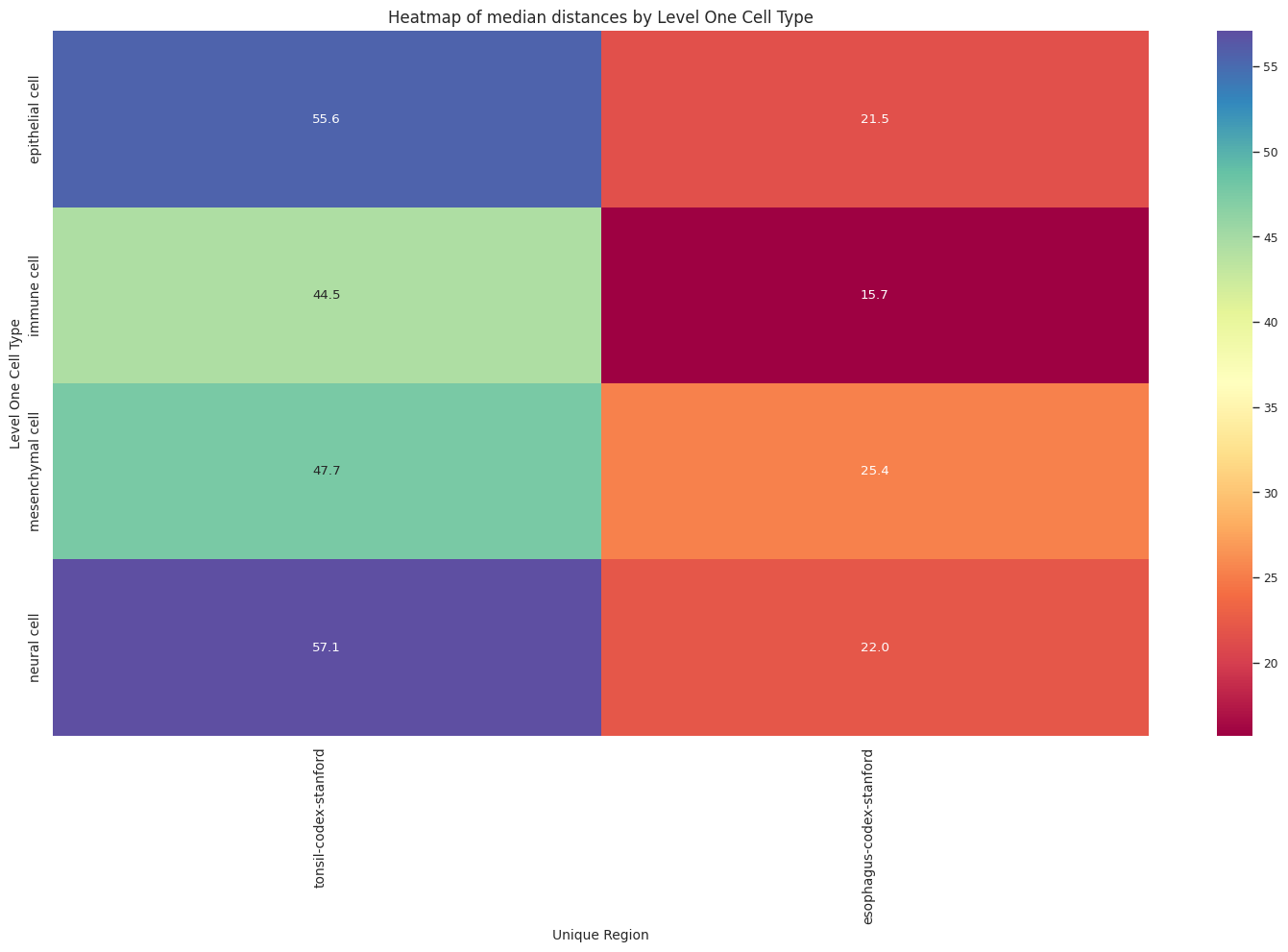
# Generate Violin Plot per unique region in both small intestine and large intestine. Create for all 8 regions as 8 subplots.
def plot_violin_plots_all_regions(df_all_edges_with_cell_type_level, cell_type_level, output_dir, density_norm="area"):
sns.set_style("whitegrid")
sns.set_context("notebook", rc={"grid.linewidth": 1})
plt.rcParams["svg.fonttype"] = 'none' # to store text as text, not as path
font_size = 10
fig, axs = plt.subplots(2, 1, figsize=(10, 15)) # Adjusted figsize for horizontal layout
fig.suptitle(f'Distance distribution per {cell_type_level} in `{dataset_dir}` (density normalization = {density_norm})', fontsize=font_size, y=1)
# Keep the sequence of Cell Types consistent across plots.
cell_types = sorted(df_all_edges_with_cell_type_level[cell_type_level].unique())
# Create a color palette based on the number of unique classes
color_palette = sns.color_palette("Spectral", n_colors=len(cell_types))
# Create a dictionary mapping class to color
class_color_dict = dict(zip(cell_types, color_palette))
for i, region in enumerate(regions):
data_reg = df_all_edges_with_cell_type_level[df_all_edges_with_cell_type_level['Unique Region'] == region]
sns.violinplot(data=data_reg, x=cell_type_level, y="Distance", density_norm=density_norm, common_norm=True, cut=0, inner="box", split=False, palette=class_color_dict, alpha=.9, ax=axs[i], hue=cell_type_level, legend=False, order=cell_types, fill=True)
axs[i].set_title(region, fontsize=font_size)
axs[i].set_xlabel('', fontsize=font_size)
axs[i].set_ylabel('Distance (\u03bcm)', fontsize=font_size)
# axs[i].tick_params(axis='x', labelrotation=90, labelsize=font_size)
# only show xtick labels for the last subplot
if i < len(regions) - 1:
axs[i].set_xticklabels([])
else:
axs[i].set_xticklabels(cell_types, fontsize=font_size, rotation=90, ha='right')
# axs[i].set_ylim(0, data_reg['Distance'].max() * 1.1) # Set y-limits to be consistent across all plots
axs[i].tick_params(axis='both', labelsize=font_size)
# Use fig.text for precise label positioning
fig.figure.text(0.5, -0.02, f'{cell_type_level}', ha='center', va='bottom', fontsize=font_size)
plt.tight_layout()
plt.savefig(os.path.join(output_dir, f'{dataset_dir}_violin_plots_all_regions_{cell_type_level}.png'), dpi=300,
bbox_inches='tight',
pad_inches=0.5)
plt.savefig(os.path.join(output_dir, f'{dataset_dir}_violin_plots_all_regions_{cell_type_level}.svg'), dpi=300,
bbox_inches='tight',
pad_inches=0.5)
plt.show()
plot_violin_plots_all_regions(df_all_edges_with_cell_type_level, cell_type_level, os.path.join(basepath, figures_output_dir), density_norm="count") # density_norm="count" or "area" can be used based on preference.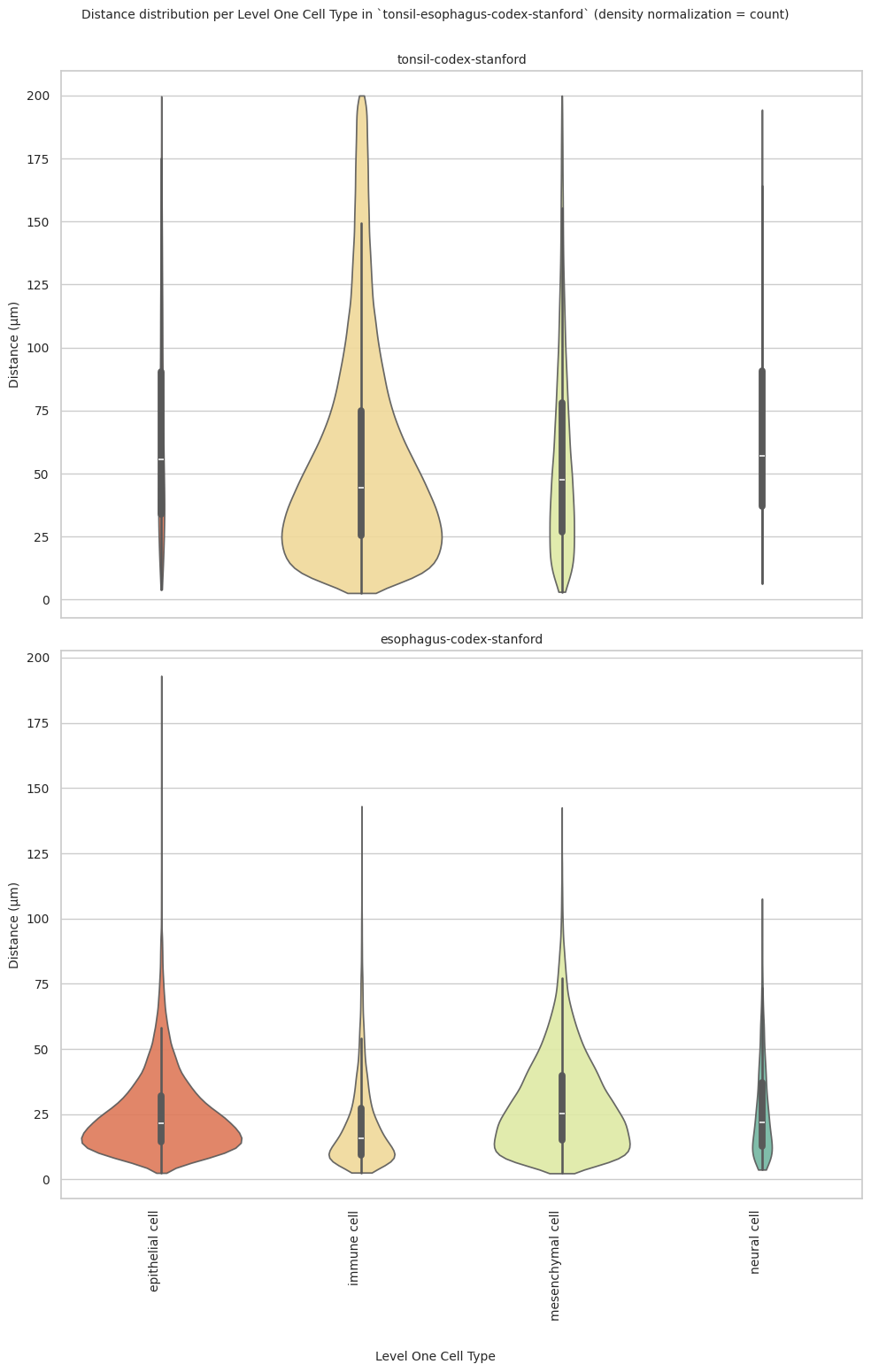
# Generate Split Violin Plot
def plot_violin_cells_per_celltype_split_by_condition(df_all_edges_with_cell_type_level, cell_type_level, output_dir, density_norm="area"):
sns.set_style("whitegrid")
sns.set_context("notebook", rc={"grid.linewidth": 2})
plt.figure(figsize=(15, 10))
plt.rcParams["svg.fonttype"] = 'none' # to store text as text, not as path
sns.violinplot(data=df_all_edges_with_cell_type_level, x=cell_type_level, y="Distance", hue="Unique Region", density_norm=density_norm, common_norm=True, cut=0, inner="box", split=True, palette='Spectral', alpha=.9, hue_order=regions)
sns.set_theme(style="whitegrid")
sns.set_context("paper")
font_size = 10
plt.legend(fontsize=font_size, loc='upper right', bbox_to_anchor=(1.15, 1))
plt.title(f'Split violin plot of distances by {cell_type_level} (Density Normalization: {density_norm})', fontsize=font_size)
plt.xlabel('Cell Type', fontsize=font_size)
plt.ylabel('Distance (\u03bcm)', fontsize=font_size)
# Increase font size for all text in the figure
plt.xticks(fontsize=font_size)
plt.xticks(rotation=90)
plt.yticks(fontsize=font_size)
plt.tight_layout()
plt.savefig(os.path.join(output_dir, f'{dataset_dir}_plot_violin_cells_per_celltype_split_by_condition_{cell_type_level}.png'), dpi=300,
bbox_inches='tight',
pad_inches=0.5)
plt.savefig(os.path.join(output_dir, f'{dataset_dir}_plot_violin_cells_per_celltype_split_by_condition_{cell_type_level}.svg'), dpi=300,
bbox_inches='tight',
pad_inches=0.5)
plt.show()
plot_violin_cells_per_celltype_split_by_condition(df_all_edges_with_cell_type_level, cell_type_level, os.path.join(basepath, figures_output_dir), density_norm="count") # density_norm="count" or "area" can be used based on preference.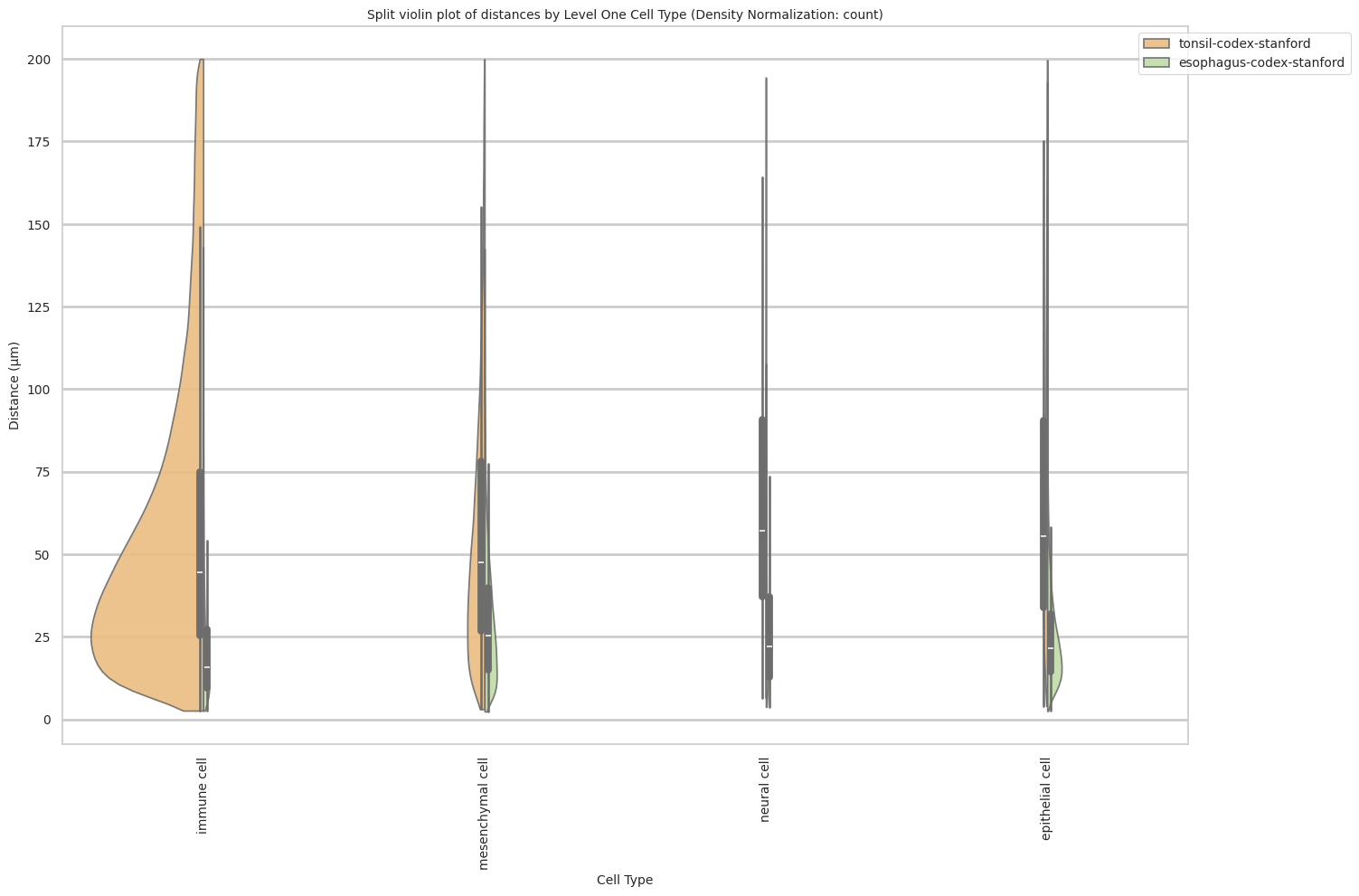
Level Two Cell Type Analysis
# Get mean, median, minimum, maximum distance per cell type in all unique regions.
cell_type_level = 'Level Two Cell Type'
df_all_edges_with_cell_type_level = df_all_edges_with_cell_types[(df_all_edges_with_cell_types['Anchor Cell Type Level'] == cell_type_level) & (df_all_edges_with_cell_types['Anchor Cell Type'] == anchor_cell_type_dict[cell_type_level])]
df_distance_stats_cell_type_level = df_all_edges_with_cell_type_level.groupby([cell_type_level, 'Unique Region']).agg(
mean_distance=('Distance', 'mean'),
median_distance=('Distance', 'median'),
min_distance=('Distance', 'min'),
max_distance=('Distance', 'max')
).reset_index()
df_distance_stats_cell_type_level| Level Two Cell Type | Unique Region | mean_distance | median_distance | min_distance | max_distance | |
|---|---|---|---|---|---|---|
| 0 | b cell | esophagus-codex-stanford | 18.969648 | 16.016955 | 3.881453 | 126.909646 |
| 1 | b cell | tonsil-codex-stanford | 53.795103 | 45.373324 | 3.016000 | 199.787236 |
| 2 | gland epithelium cell | esophagus-codex-stanford | 24.161285 | 20.704132 | 2.528993 | 193.046457 |
| 3 | lymphoid cell | esophagus-codex-stanford | 22.645679 | 15.703303 | 2.639000 | 143.075846 |
| 4 | lymphoid cell | tonsil-codex-stanford | 71.002055 | 53.958434 | 3.016000 | 199.993437 |
| 5 | muscle cell | esophagus-codex-stanford | 29.075721 | 25.112275 | 3.371991 | 121.626183 |
| 6 | muscle cell | tonsil-codex-stanford | 14.724496 | 11.403859 | 4.214988 | 59.595818 |
| 7 | neuron | esophagus-codex-stanford | 26.639884 | 22.024674 | 3.788803 | 107.653801 |
| 8 | neuron | tonsil-codex-stanford | 66.127466 | 57.077850 | 6.409000 | 194.409948 |
| 9 | paneth cell | esophagus-codex-stanford | 40.358060 | 42.616011 | 4.586403 | 75.125232 |
| 10 | secretory cell of esophagus | esophagus-codex-stanford | 24.726692 | 22.005202 | 2.871146 | 87.171824 |
| 11 | squamous epithelial cell | esophagus-codex-stanford | 37.731198 | 35.148048 | 4.723796 | 127.522444 |
| 12 | squamous epithelial cell | tonsil-codex-stanford | 65.469626 | 55.553479 | 4.060414 | 199.673736 |
| 13 | stromal cell | esophagus-codex-stanford | 30.144150 | 26.062121 | 2.384357 | 142.577791 |
| 14 | stromal cell | tonsil-codex-stanford | 57.484964 | 47.978342 | 3.108822 | 199.931243 |
| 15 | t cell | esophagus-codex-stanford | 20.056056 | 15.309171 | 3.413880 | 111.112076 |
| 16 | t cell | tonsil-codex-stanford | 44.040178 | 38.233451 | 2.639000 | 199.934442 |
# Get top and bottom cell types for each unique region in the dataset.
unique_regions = df_all_edges_with_cell_type_level['Unique Region'].unique()
for region in unique_regions:
top_bottom = get_top_bottom_cell_types_by_mean(df_all_edges_with_cell_type_level, cell_type_level, region)
print(f"\nTop 5 cell types in {region}:")
print(top_bottom[0])
print(f"\nBottom 5 cell types in {region}:")
print(top_bottom[1])
Top 5 cell types in tonsil-codex-stanford:
Level Two Cell Type mean_distance
1 lymphoid cell 71.002055
3 neuron 66.127466
4 squamous epithelial cell 65.469626
5 stromal cell 57.484964
0 b cell 53.795103
Bottom 5 cell types in tonsil-codex-stanford:
Level Two Cell Type mean_distance
4 squamous epithelial cell 65.469626
5 stromal cell 57.484964
0 b cell 53.795103
6 t cell 44.040178
2 muscle cell 14.724496
Top 5 cell types in esophagus-codex-stanford:
Level Two Cell Type mean_distance
5 paneth cell 40.358060
7 squamous epithelial cell 37.731198
8 stromal cell 30.144150
3 muscle cell 29.075721
4 neuron 26.639884
Bottom 5 cell types in esophagus-codex-stanford:
Level Two Cell Type mean_distance
6 secretory cell of esophagus 24.726692
1 gland epithelium cell 24.161285
2 lymphoid cell 22.645679
9 t cell 20.056056
0 b cell 18.969648# Get top and bottom cell types for each unique region in the dataset.
unique_regions = df_all_edges_with_cell_type_level['Unique Region'].unique()
for region in unique_regions:
top_bottom = get_top_bottom_cell_types_by_median(df_all_edges_with_cell_type_level, cell_type_level, region)
print(f"\nTop 5 cell types in {region}:")
print(top_bottom[0])
print(f"\nBottom 5 cell types in {region}:")
print(top_bottom[1])
Top 5 cell types in tonsil-codex-stanford:
Level Two Cell Type median_distance
3 neuron 57.077850
4 squamous epithelial cell 55.553479
1 lymphoid cell 53.958434
5 stromal cell 47.978342
0 b cell 45.373324
Bottom 5 cell types in tonsil-codex-stanford:
Level Two Cell Type median_distance
1 lymphoid cell 53.958434
5 stromal cell 47.978342
0 b cell 45.373324
6 t cell 38.233451
2 muscle cell 11.403859
Top 5 cell types in esophagus-codex-stanford:
Level Two Cell Type median_distance
5 paneth cell 42.616011
7 squamous epithelial cell 35.148048
8 stromal cell 26.062121
3 muscle cell 25.112275
4 neuron 22.024674
Bottom 5 cell types in esophagus-codex-stanford:
Level Two Cell Type median_distance
6 secretory cell of esophagus 22.005202
1 gland epithelium cell 20.704132
0 b cell 16.016955
2 lymphoid cell 15.703303
9 t cell 15.309171calculate_regional_variability(df_all_edges_with_cell_type_level, cell_type_level)
Regional Variability Analysis:
Mean: Average distance in each region
Std: Standard deviation of distances
CV: Coefficient of Variation (std/mean * 100%)
mean std CV (%)
Unique Region
esophagus-codex-stanford 26.2 17.46 66.6
tonsil-codex-stanford 56.9 42.08 74.0
Cell Type Variability Analysis (sorted by CV):
mean std CV (%)
Level Two Cell Type
neuron 31.35 24.62 78.5
lymphoid cell 67.06 52.45 78.2
stromal cell 51.86 38.02 73.3
b cell 52.62 36.47 69.3
squamous epithelial cell 60.43 39.56 65.5
t cell 43.36 28.24 65.1
muscle cell 28.84 18.34 63.6
gland epithelium cell 24.16 14.80 61.3
secretory cell of esophagus 24.73 14.31 57.9
paneth cell 40.36 16.31 40.4plot_violin_cells_per_celltype(df_all_edges_with_cell_type_level, cell_type_level, os.path.join(basepath, figures_output_dir), density_norm='area')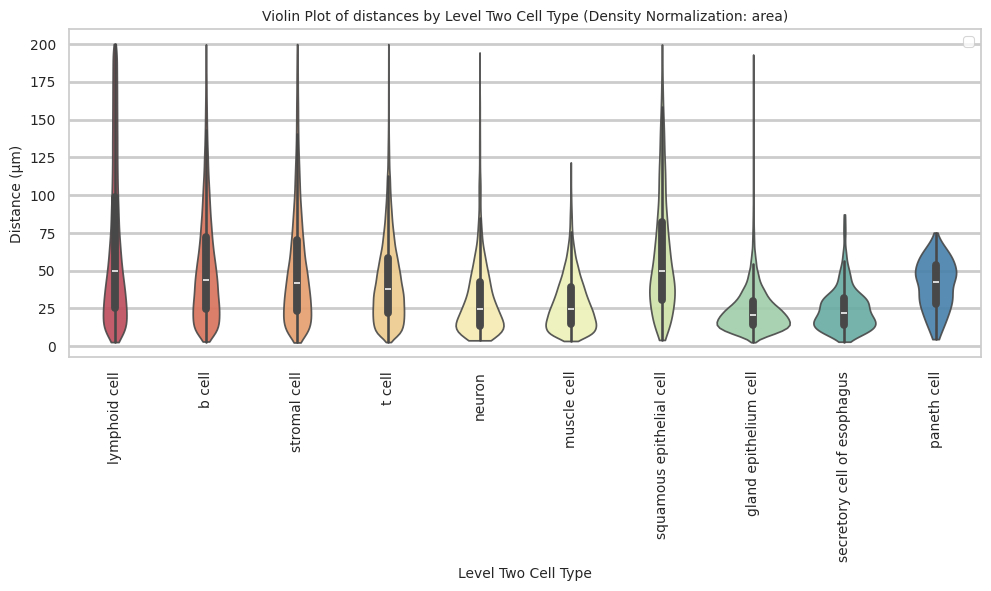
plot_distance_distribution_boxplots_by_region(df_all_edges_with_cell_type_level, cell_type_level, os.path.join(basepath, figures_output_dir))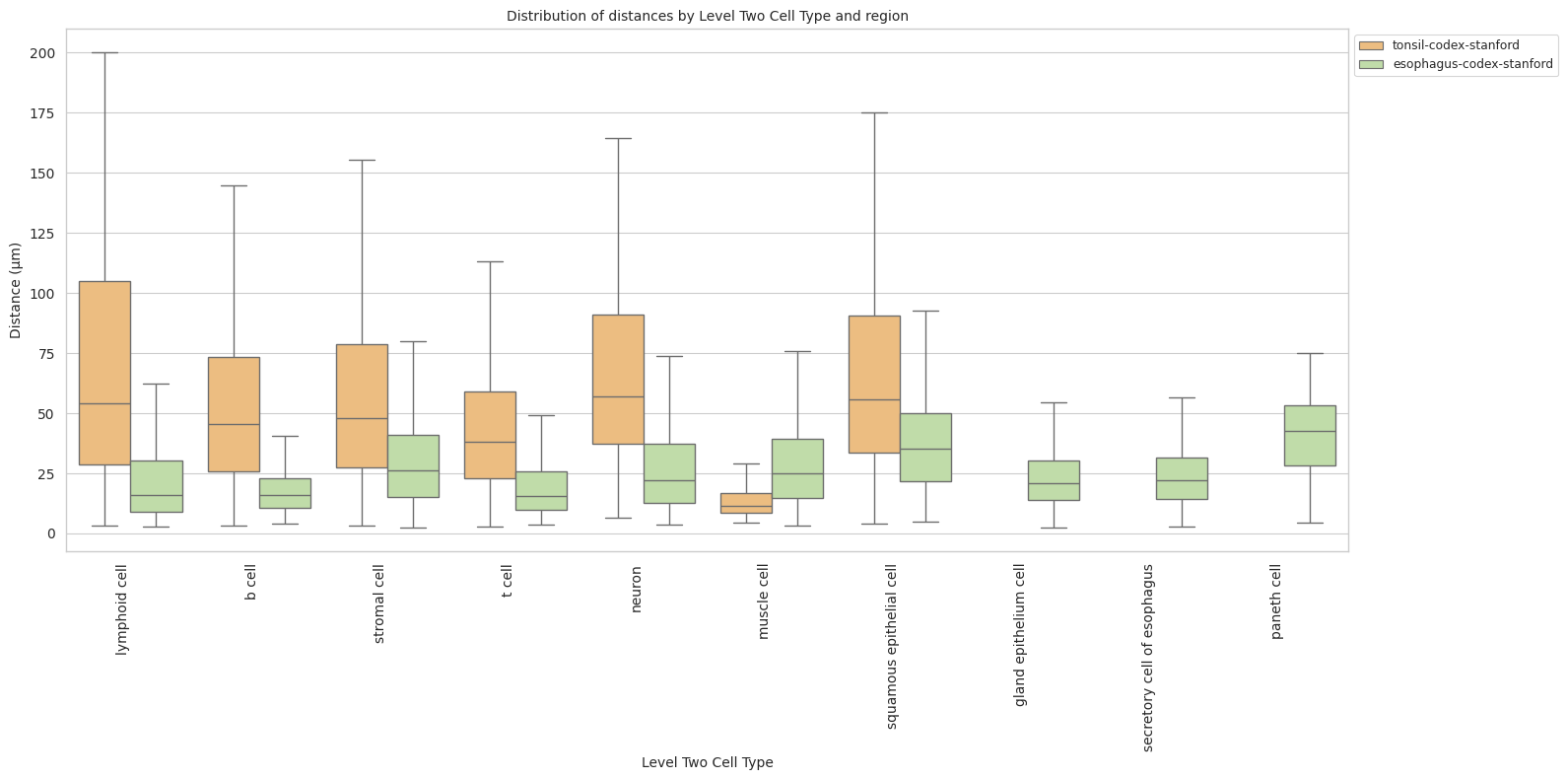
plot_distance_distribution_heatmap(df_all_edges_with_cell_type_level, cell_type_level, os.path.join(basepath, figures_output_dir))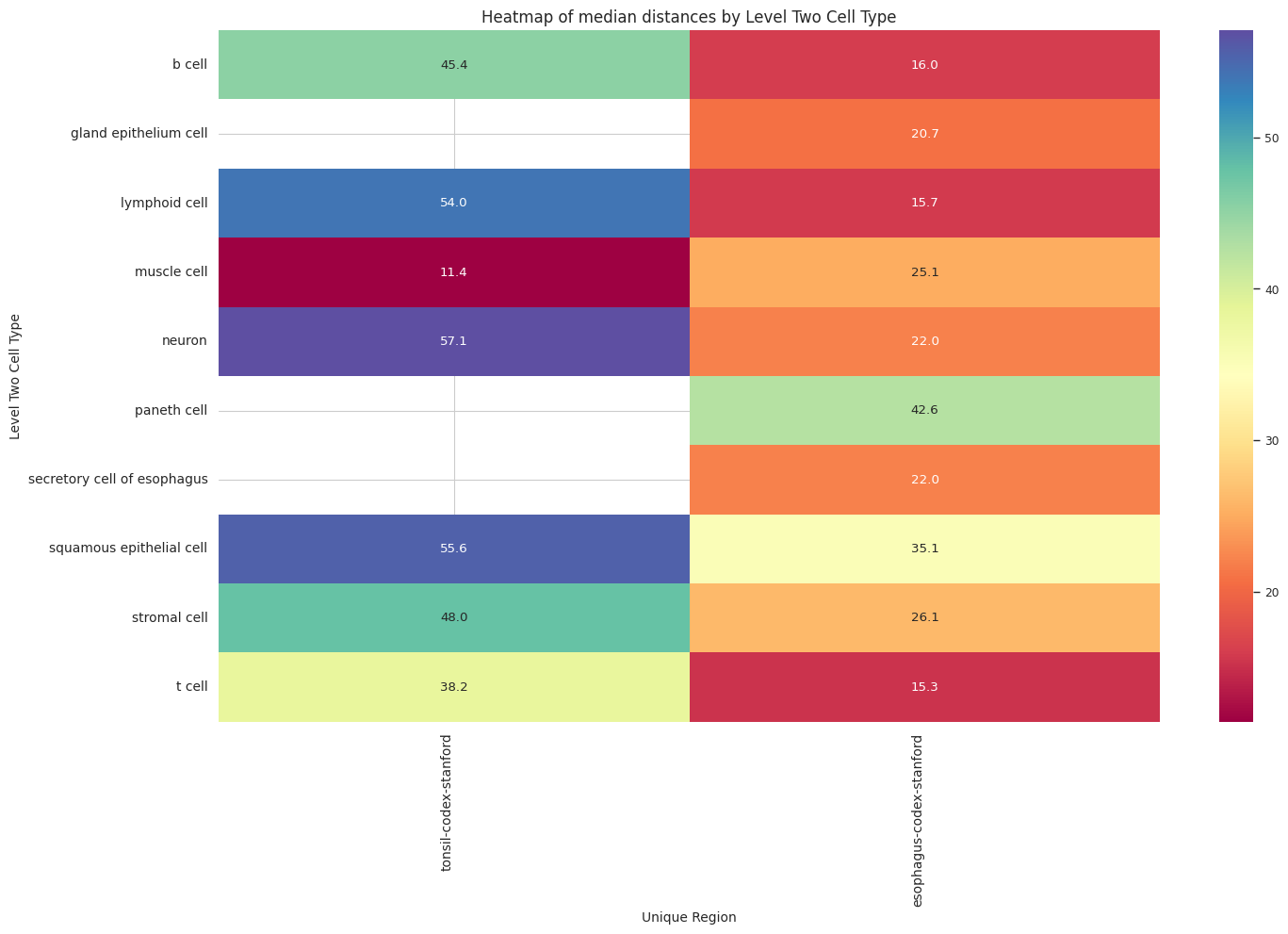
plot_violin_plots_all_regions(df_all_edges_with_cell_type_level, cell_type_level, os.path.join(basepath, figures_output_dir), density_norm="count") # Or, density_norm="count" or "area" based on preference.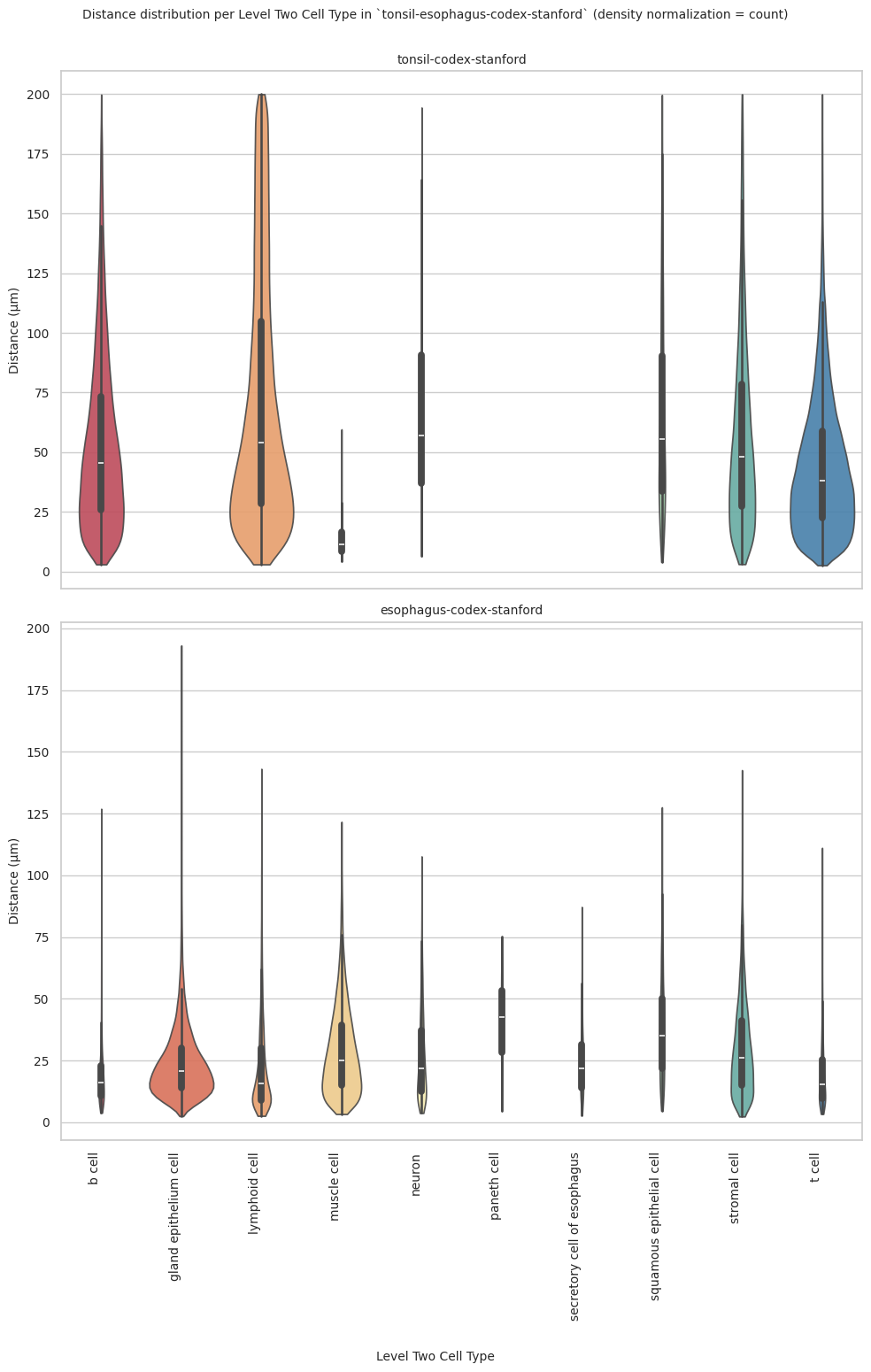
plot_violin_cells_per_celltype_split_by_condition(df_all_edges_with_cell_type_level, cell_type_level, os.path.join(basepath, figures_output_dir), density_norm="count") # density_norm="count" or "area" can be used based on preference.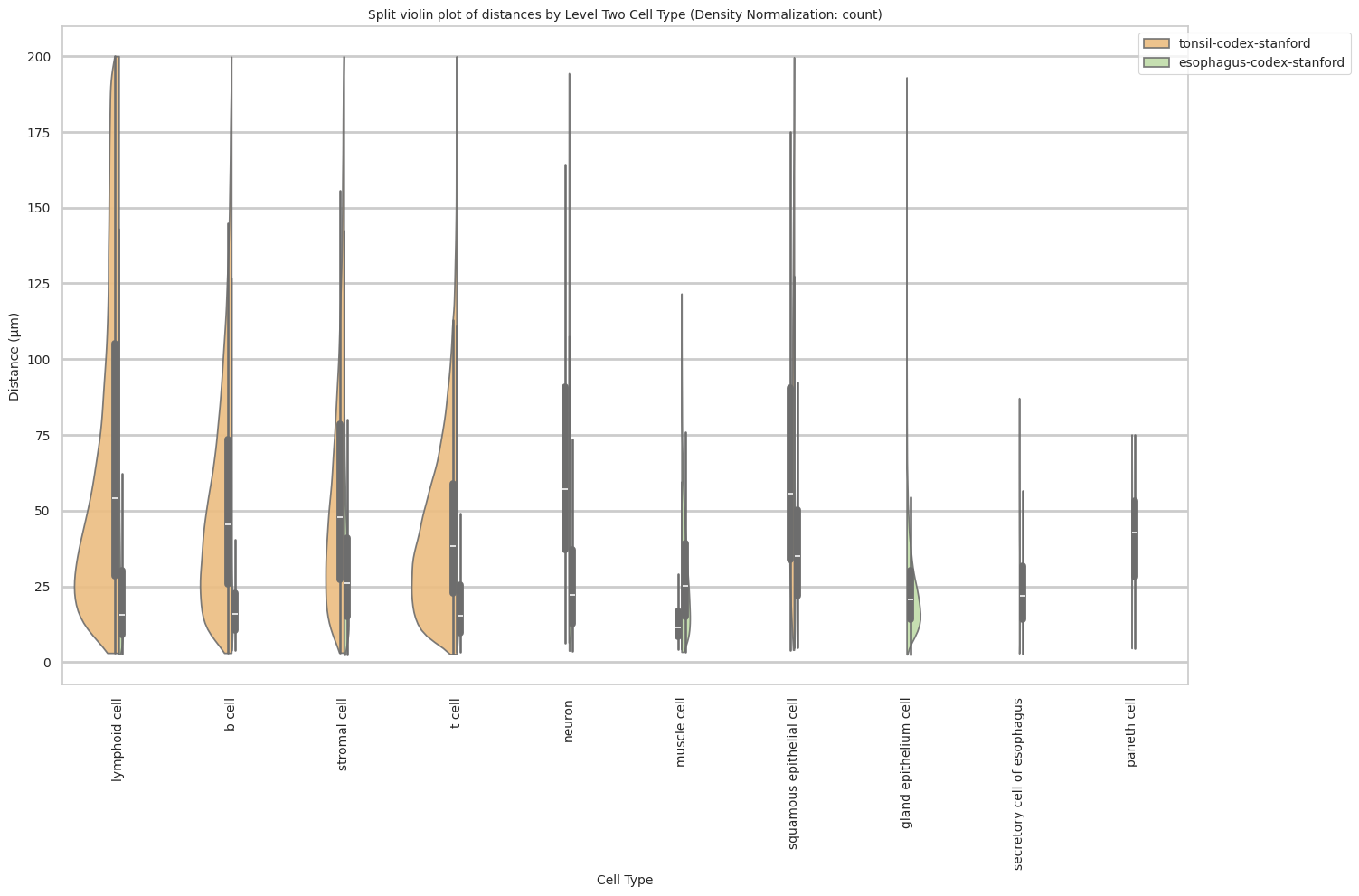
Level Three Cell Type Analysis
# Get mean, median, minimum, maximum distance per cell type in all unique regions.
cell_type_level = 'Level Three Cell Type'
df_all_edges_with_cell_type_level = df_all_edges_with_cell_types[(df_all_edges_with_cell_types['Anchor Cell Type Level'] == cell_type_level) & (df_all_edges_with_cell_types['Anchor Cell Type'] == anchor_cell_type_dict[cell_type_level])]
df_distance_stats_cell_type_level = df_all_edges_with_cell_type_level.groupby([cell_type_level, 'Unique Region']).agg(
mean_distance=('Distance', 'mean'),
median_distance=('Distance', 'median'),
min_distance=('Distance', 'min'),
max_distance=('Distance', 'max')
).reset_index()
df_distance_stats_cell_type_level| Level Three Cell Type | Unique Region | mean_distance | median_distance | min_distance | max_distance | |
|---|---|---|---|---|---|---|
| 0 | b cell | tonsil-codex-stanford | 55.759563 | 47.530416 | 3.016000 | 199.787236 |
| 1 | epithelial cell:secretory | esophagus-codex-stanford | 24.726692 | 22.005202 | 2.871146 | 87.171824 |
| 2 | glandular cell of esophagus | esophagus-codex-stanford | 24.161285 | 20.704132 | 2.528993 | 193.046457 |
| 3 | lymphoid cell:innate | esophagus-codex-stanford | 22.645679 | 15.703303 | 2.639000 | 143.075846 |
| 4 | lymphoid cell:innate | tonsil-codex-stanford | 71.002055 | 53.958434 | 3.016000 | 199.993437 |
| 5 | muscle cell:smooth | esophagus-codex-stanford | 29.075721 | 25.112275 | 3.371991 | 121.626183 |
| 6 | muscle cell:smooth | tonsil-codex-stanford | 14.724496 | 11.403859 | 4.214988 | 59.595818 |
| 7 | neuron | esophagus-codex-stanford | 26.639884 | 22.024674 | 3.788803 | 107.653801 |
| 8 | neuron | tonsil-codex-stanford | 66.127466 | 57.077850 | 6.409000 | 194.409948 |
| 9 | paneth cell | esophagus-codex-stanford | 40.358060 | 42.616011 | 4.586403 | 75.125232 |
| 10 | plasma cell | esophagus-codex-stanford | 18.969648 | 16.016955 | 3.881453 | 126.909646 |
| 11 | plasma cell | tonsil-codex-stanford | 26.122452 | 18.626242 | 3.039471 | 195.892407 |
| 12 | squamous epithelial cell | esophagus-codex-stanford | 37.731198 | 35.148048 | 4.723796 | 127.522444 |
| 13 | squamous epithelial cell | tonsil-codex-stanford | 65.469626 | 55.553479 | 4.060414 | 199.673736 |
| 14 | stromal cell | esophagus-codex-stanford | 29.426691 | 24.946174 | 2.384357 | 142.577791 |
| 15 | stromal cell | tonsil-codex-stanford | 58.536073 | 46.646038 | 3.108822 | 199.931243 |
| 16 | stromal cell:podoplanin+ | esophagus-codex-stanford | 33.455139 | 30.538157 | 3.713019 | 107.070655 |
| 17 | stromal cell:podoplanin+ | tonsil-codex-stanford | 56.732338 | 48.751217 | 3.221089 | 199.928400 |
| 18 | t cell | esophagus-codex-stanford | 20.056056 | 15.309171 | 3.413880 | 111.112076 |
| 19 | t cell | tonsil-codex-stanford | 44.040178 | 38.233451 | 2.639000 | 199.934442 |
# Get top and bottom cell types for each unique region in the dataset.
unique_regions = df_all_edges_with_cell_type_level['Unique Region'].unique()
for region in unique_regions:
top_bottom = get_top_bottom_cell_types_by_mean(df_all_edges_with_cell_type_level, cell_type_level, region)
print(f"\nTop 5 cell types in {region}:")
print(top_bottom[0])
print(f"\nBottom 5 cell types in {region}:")
print(top_bottom[1])
Top 5 cell types in tonsil-codex-stanford:
Level Three Cell Type mean_distance
1 lymphoid cell:innate 71.002055
3 neuron 66.127466
5 squamous epithelial cell 65.469626
6 stromal cell 58.536073
7 stromal cell:podoplanin+ 56.732338
Bottom 5 cell types in tonsil-codex-stanford:
Level Three Cell Type mean_distance
7 stromal cell:podoplanin+ 56.732338
0 b cell 55.759563
8 t cell 44.040178
4 plasma cell 26.122452
2 muscle cell:smooth 14.724496
Top 5 cell types in esophagus-codex-stanford:
Level Three Cell Type mean_distance
5 paneth cell 40.358060
7 squamous epithelial cell 37.731198
9 stromal cell:podoplanin+ 33.455139
8 stromal cell 29.426691
3 muscle cell:smooth 29.075721
Bottom 5 cell types in esophagus-codex-stanford:
Level Three Cell Type mean_distance
0 epithelial cell:secretory 24.726692
1 glandular cell of esophagus 24.161285
2 lymphoid cell:innate 22.645679
10 t cell 20.056056
6 plasma cell 18.969648# Get top and bottom cell types for each unique region in the dataset.
unique_regions = df_all_edges_with_cell_type_level['Unique Region'].unique()
for region in unique_regions:
top_bottom = get_top_bottom_cell_types_by_median(df_all_edges_with_cell_type_level, cell_type_level, region)
print(f"\nTop 5 cell types in {region}:")
print(top_bottom[0])
print(f"\nBottom 5 cell types in {region}:")
print(top_bottom[1])
Top 5 cell types in tonsil-codex-stanford:
Level Three Cell Type median_distance
3 neuron 57.077850
5 squamous epithelial cell 55.553479
1 lymphoid cell:innate 53.958434
7 stromal cell:podoplanin+ 48.751217
0 b cell 47.530416
Bottom 5 cell types in tonsil-codex-stanford:
Level Three Cell Type median_distance
0 b cell 47.530416
6 stromal cell 46.646038
8 t cell 38.233451
4 plasma cell 18.626242
2 muscle cell:smooth 11.403859
Top 5 cell types in esophagus-codex-stanford:
Level Three Cell Type median_distance
5 paneth cell 42.616011
7 squamous epithelial cell 35.148048
9 stromal cell:podoplanin+ 30.538157
3 muscle cell:smooth 25.112275
8 stromal cell 24.946174
Bottom 5 cell types in esophagus-codex-stanford:
Level Three Cell Type median_distance
0 epithelial cell:secretory 22.005202
1 glandular cell of esophagus 20.704132
6 plasma cell 16.016955
2 lymphoid cell:innate 15.703303
10 t cell 15.309171calculate_regional_variability(df_all_edges_with_cell_type_level, cell_type_level)
Regional Variability Analysis:
Mean: Average distance in each region
Std: Standard deviation of distances
CV: Coefficient of Variation (std/mean * 100%)
mean std CV (%)
Unique Region
esophagus-codex-stanford 26.2 17.46 66.6
tonsil-codex-stanford 56.9 42.08 74.0
Cell Type Variability Analysis (sorted by CV):
mean std CV (%)
Level Three Cell Type
plasma cell 23.66 20.60 87.1
stromal cell 48.70 39.75 81.6
neuron 31.35 24.62 78.5
lymphoid cell:innate 67.06 52.45 78.2
squamous epithelial cell 60.43 39.56 65.5
b cell 55.76 36.44 65.4
stromal cell:podoplanin+ 55.02 35.92 65.3
t cell 43.36 28.24 65.1
muscle cell:smooth 28.84 18.34 63.6
glandular cell of esophagus 24.16 14.80 61.3
epithelial cell:secretory 24.73 14.31 57.9
paneth cell 40.36 16.31 40.4plot_violin_cells_per_celltype(df_all_edges_with_cell_type_level, cell_type_level, os.path.join(basepath, figures_output_dir), density_norm='area')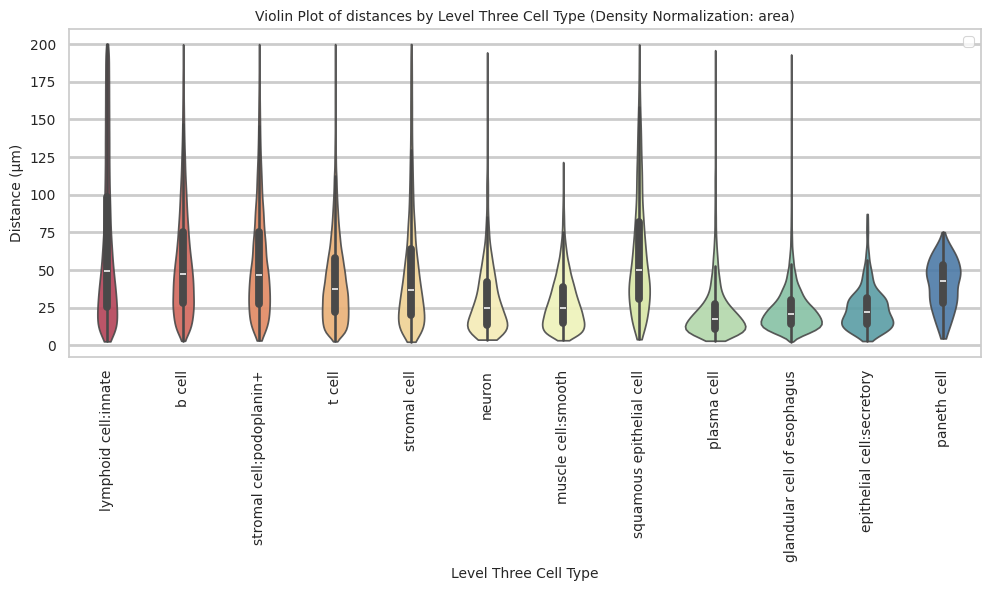
plot_distance_distribution_boxplots_by_region(df_all_edges_with_cell_type_level, cell_type_level, os.path.join(basepath, figures_output_dir))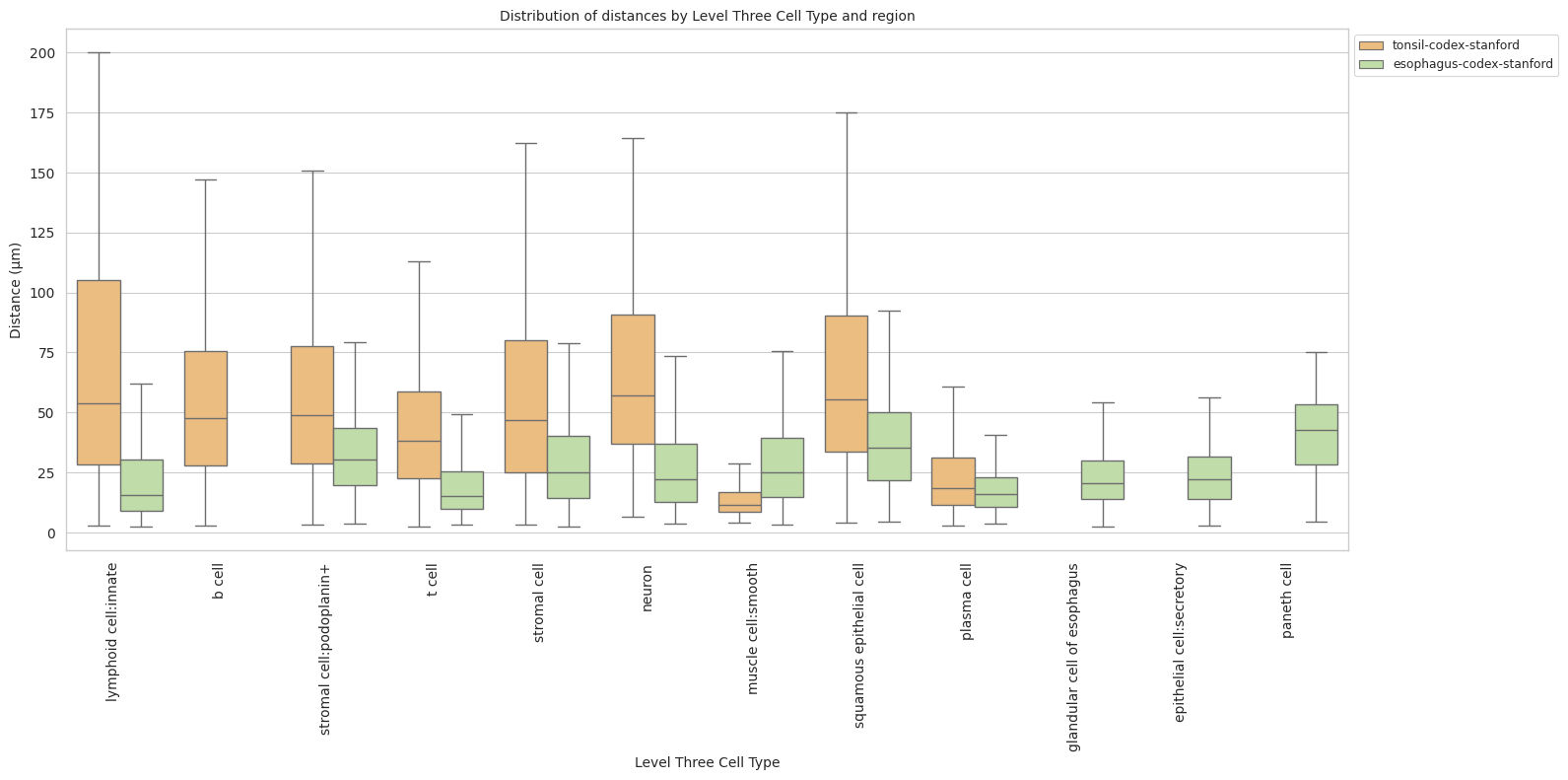
plot_distance_distribution_heatmap(df_all_edges_with_cell_type_level, cell_type_level, os.path.join(basepath, figures_output_dir))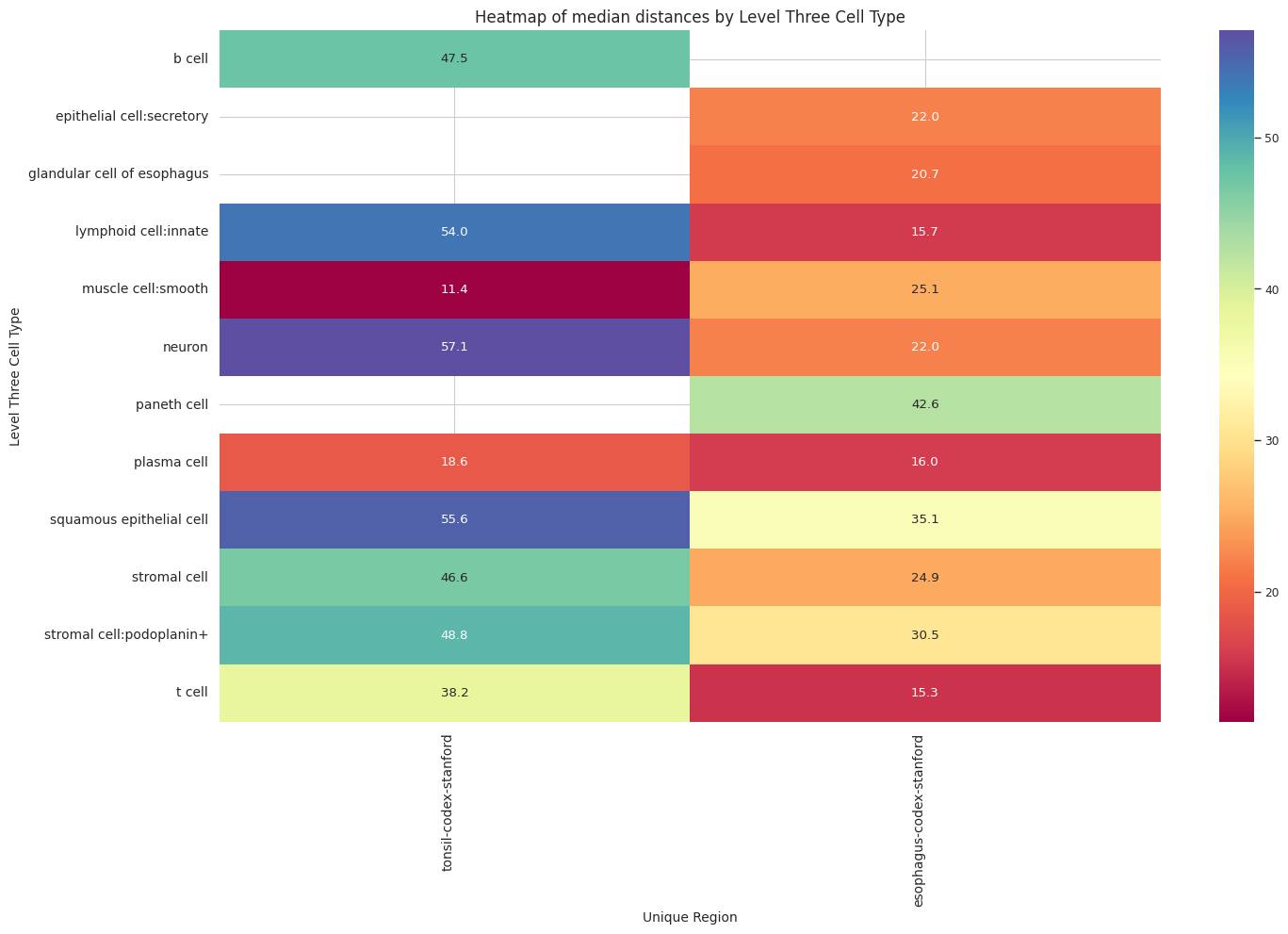
plot_violin_plots_all_regions(df_all_edges_with_cell_type_level, cell_type_level, os.path.join(basepath, figures_output_dir), density_norm="count") # Or, density_norm="count" or "area" based on preference.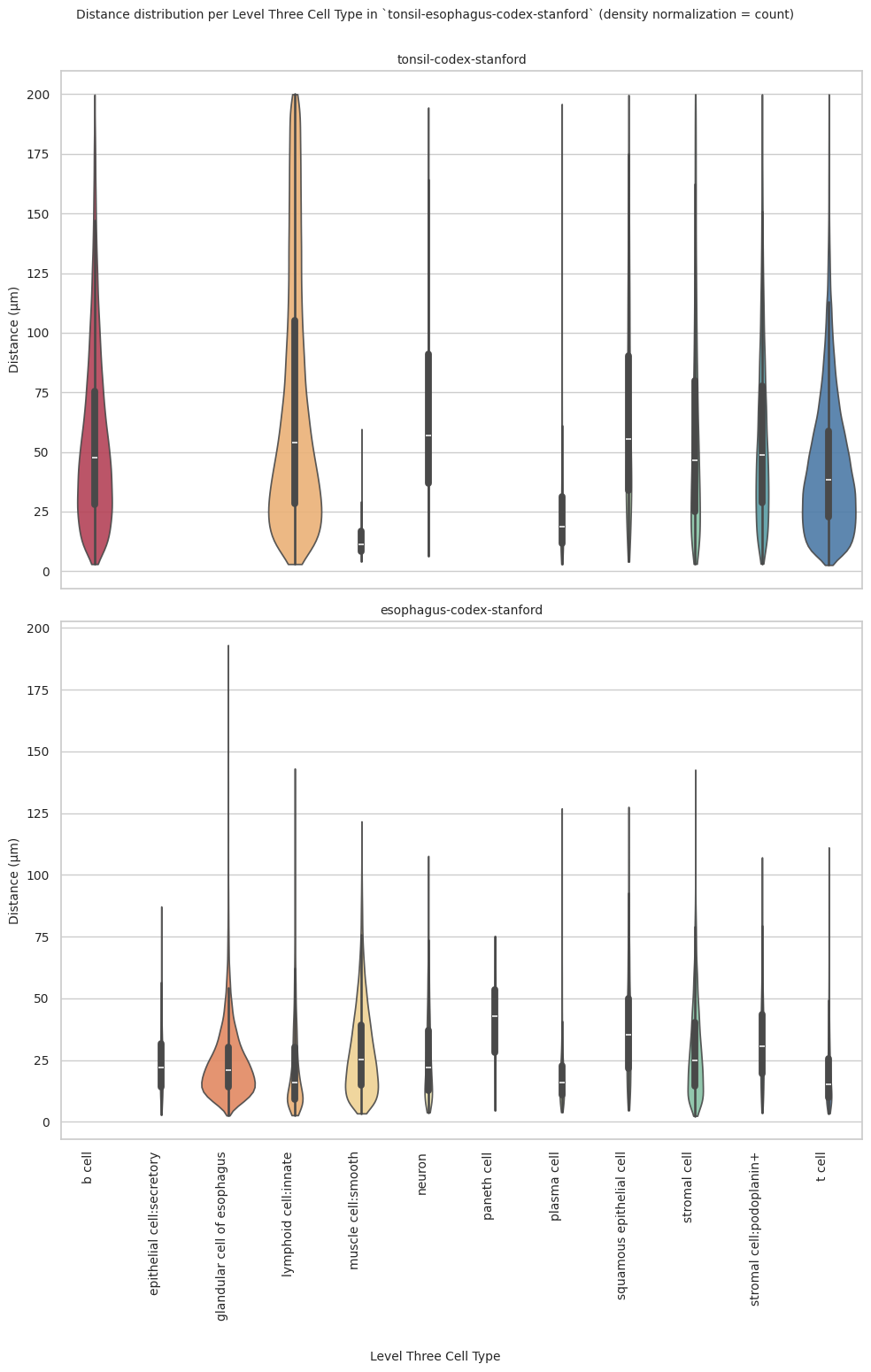
plot_violin_cells_per_celltype_split_by_condition(df_all_edges_with_cell_type_level, cell_type_level, os.path.join(basepath, figures_output_dir), density_norm="count") # density_norm="count" or "area" can be used based on preference.